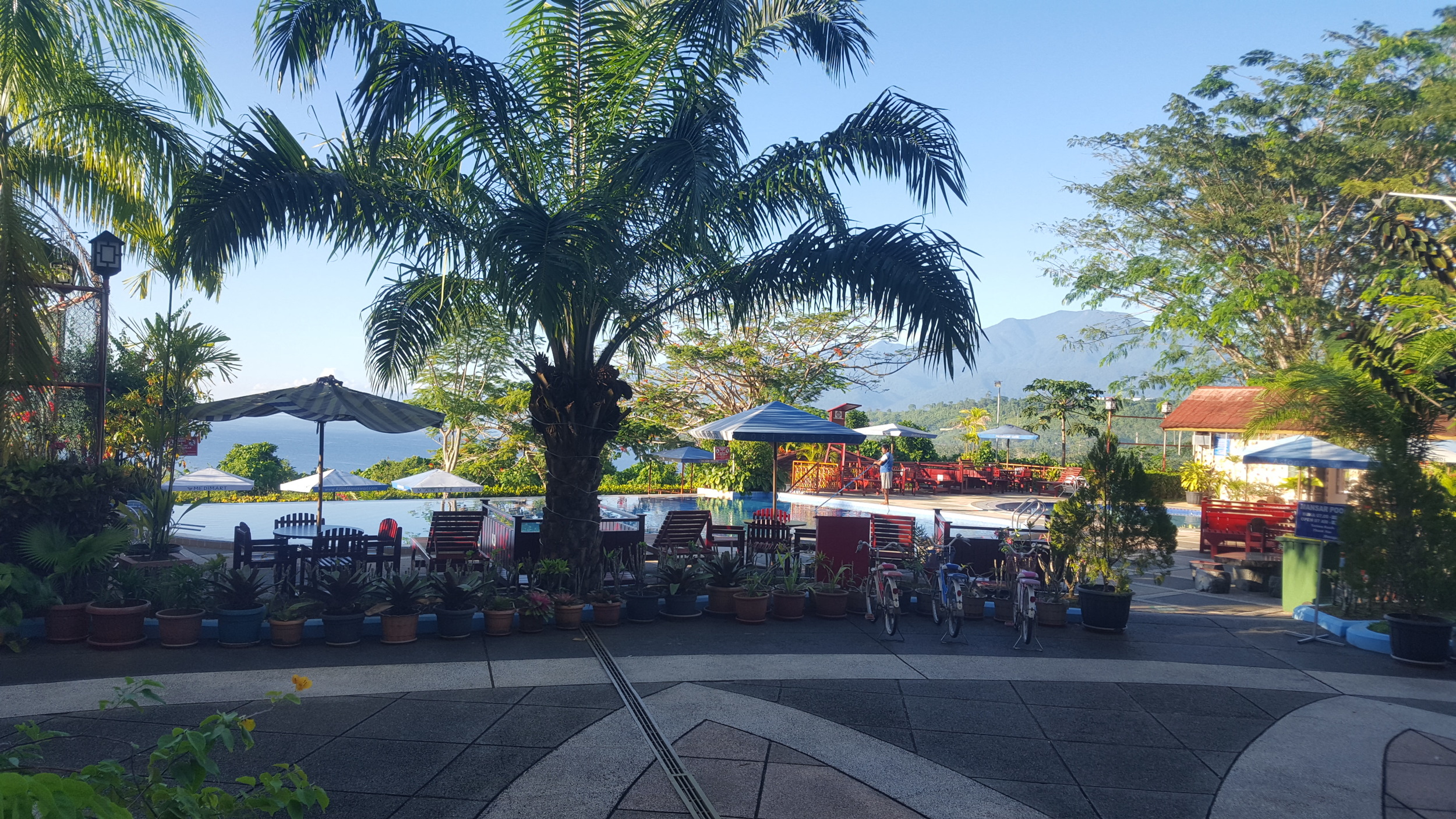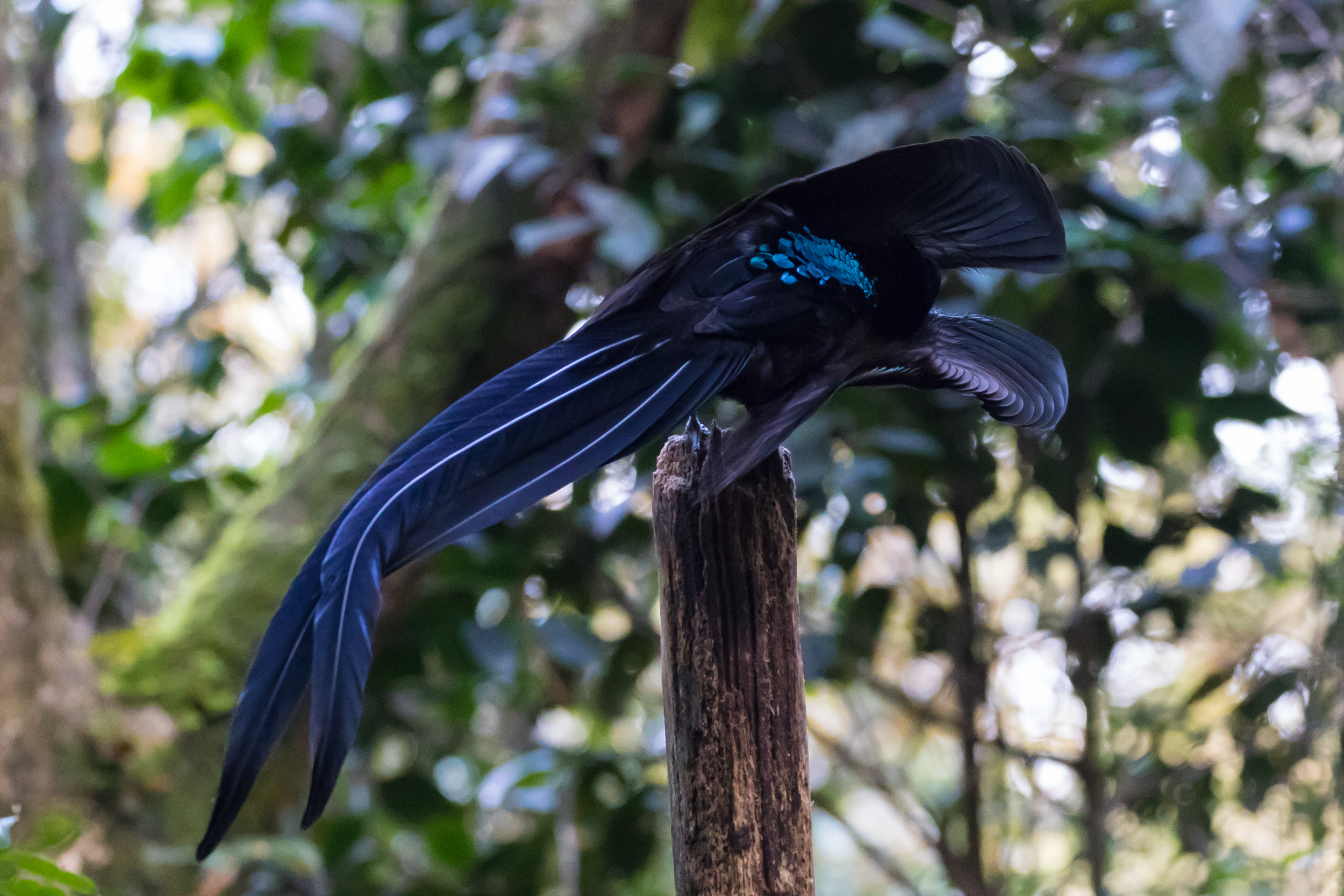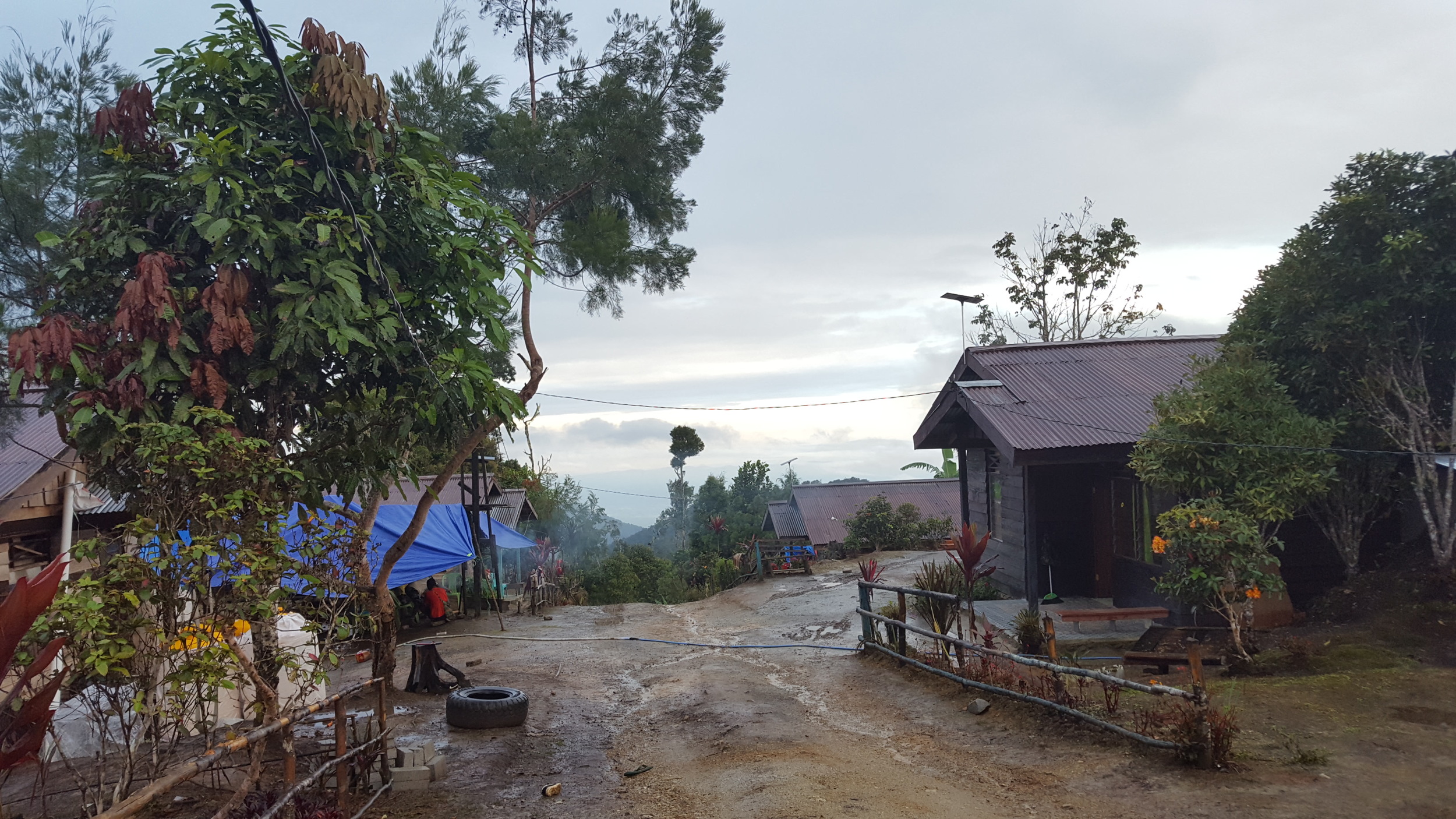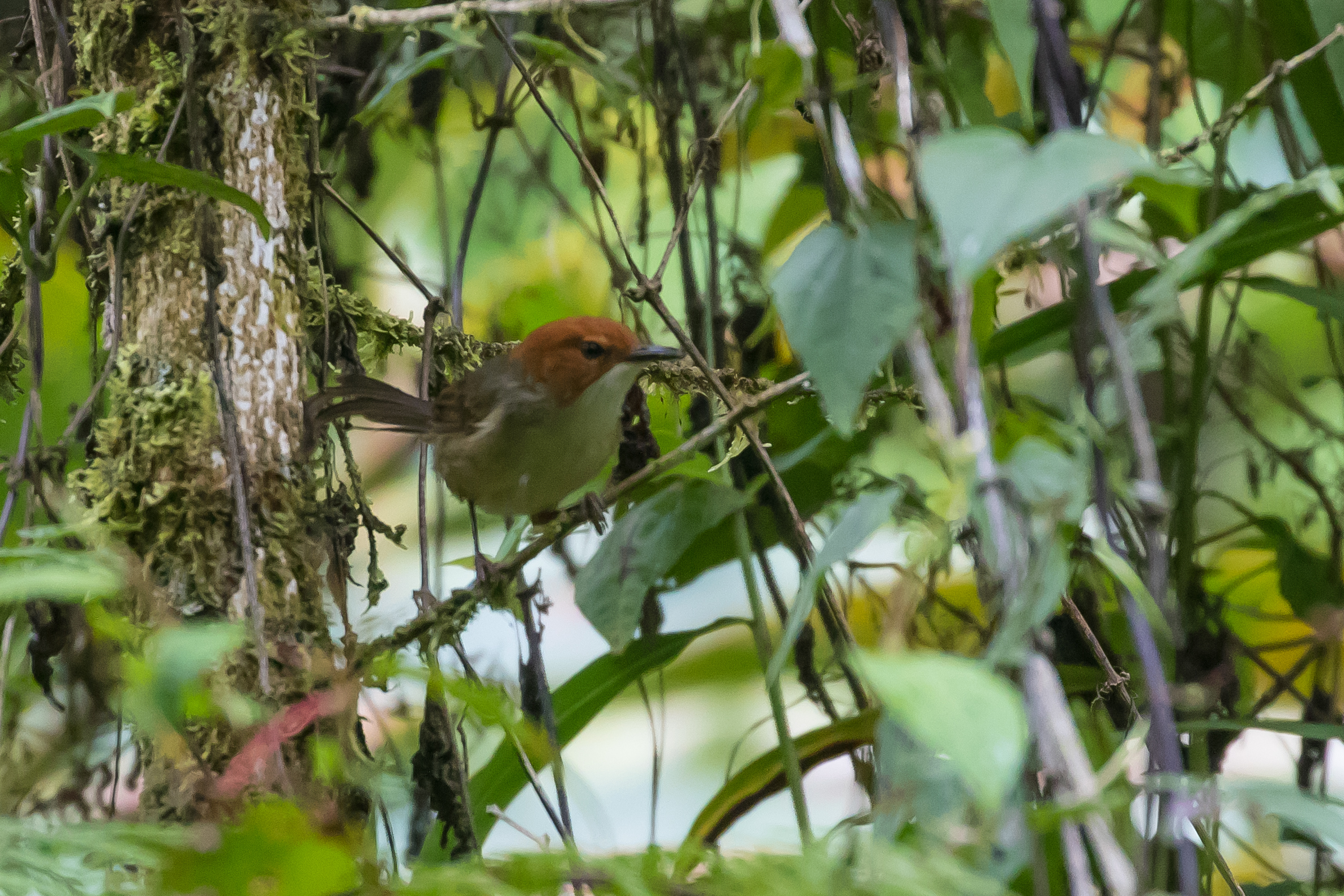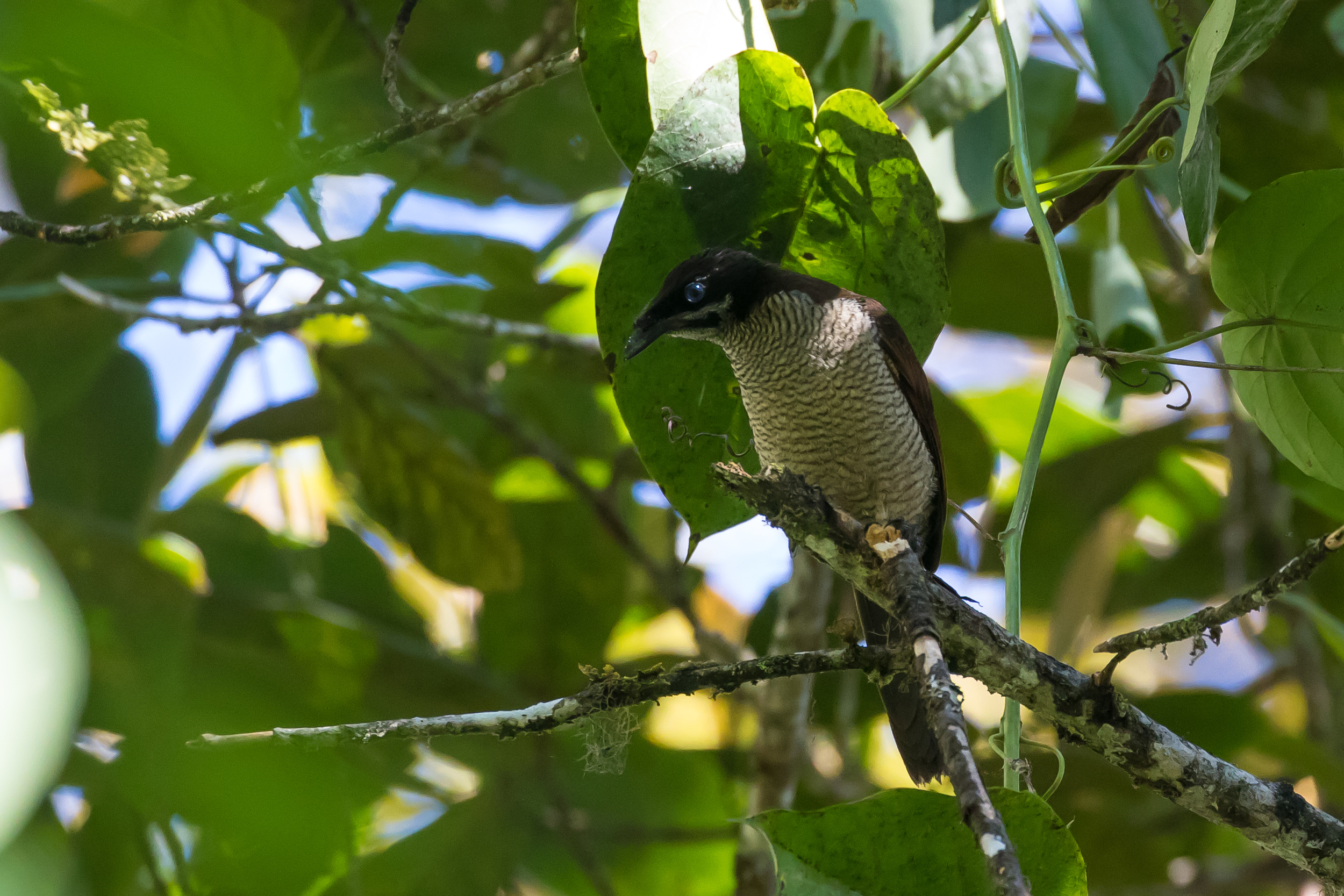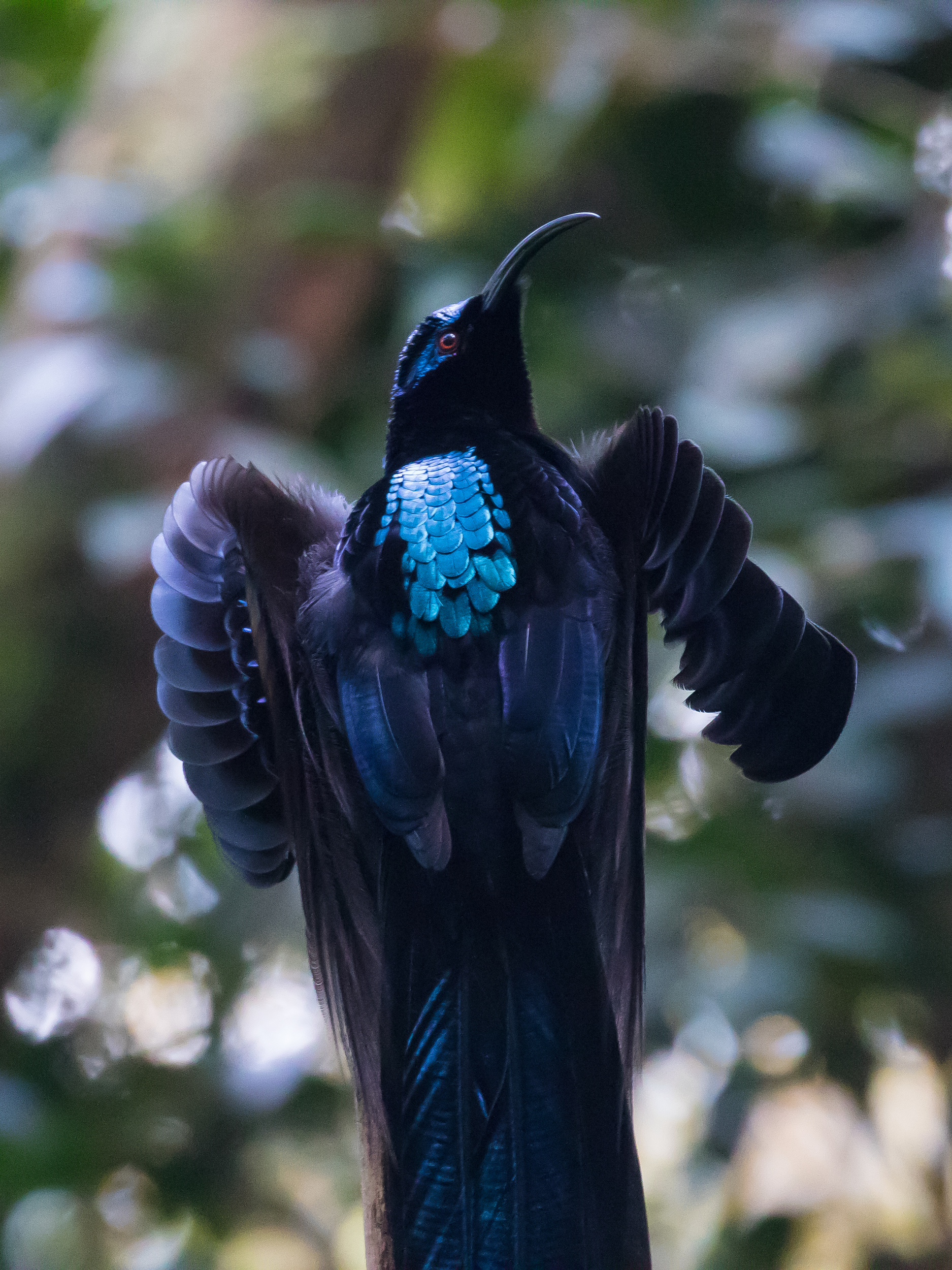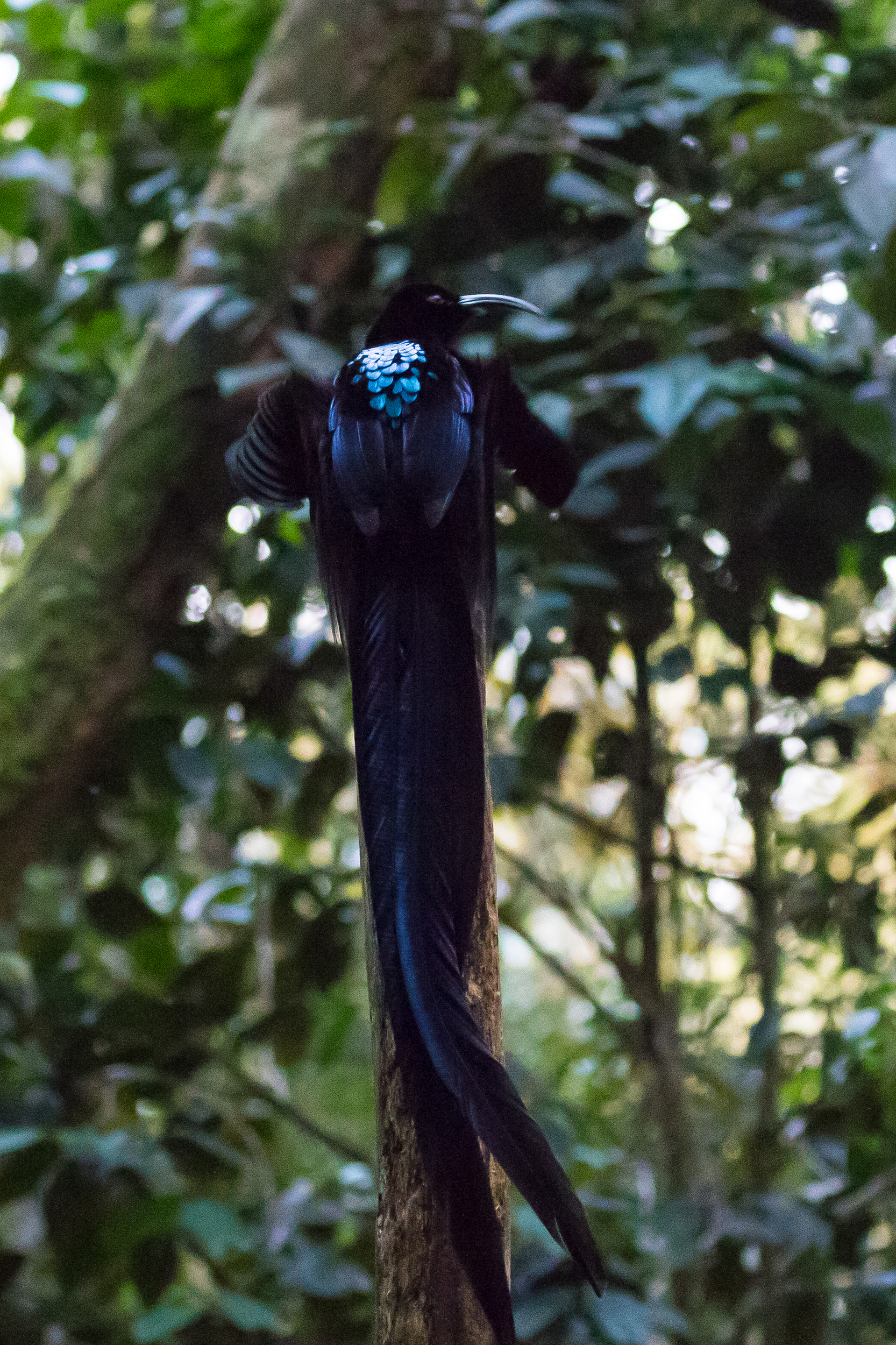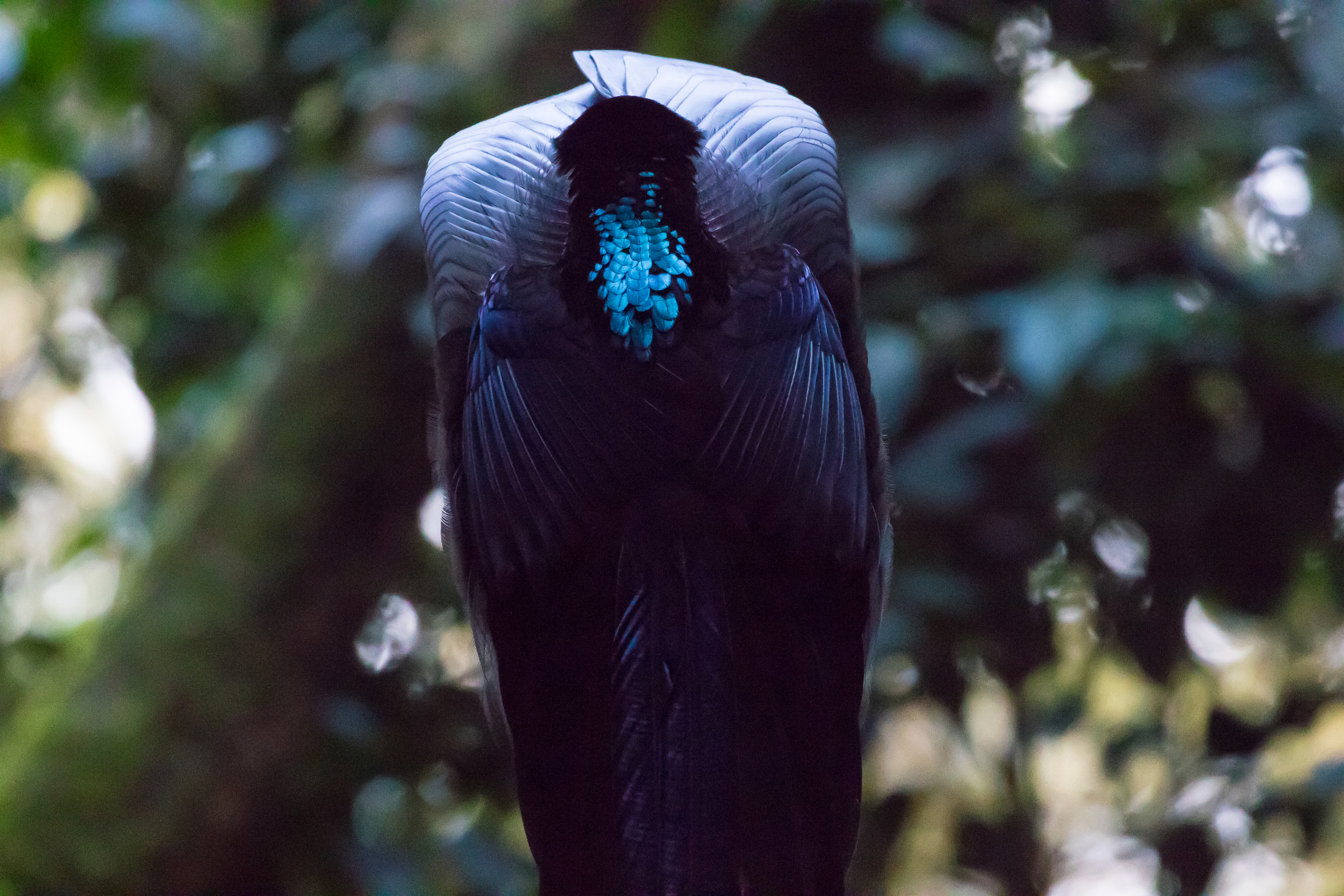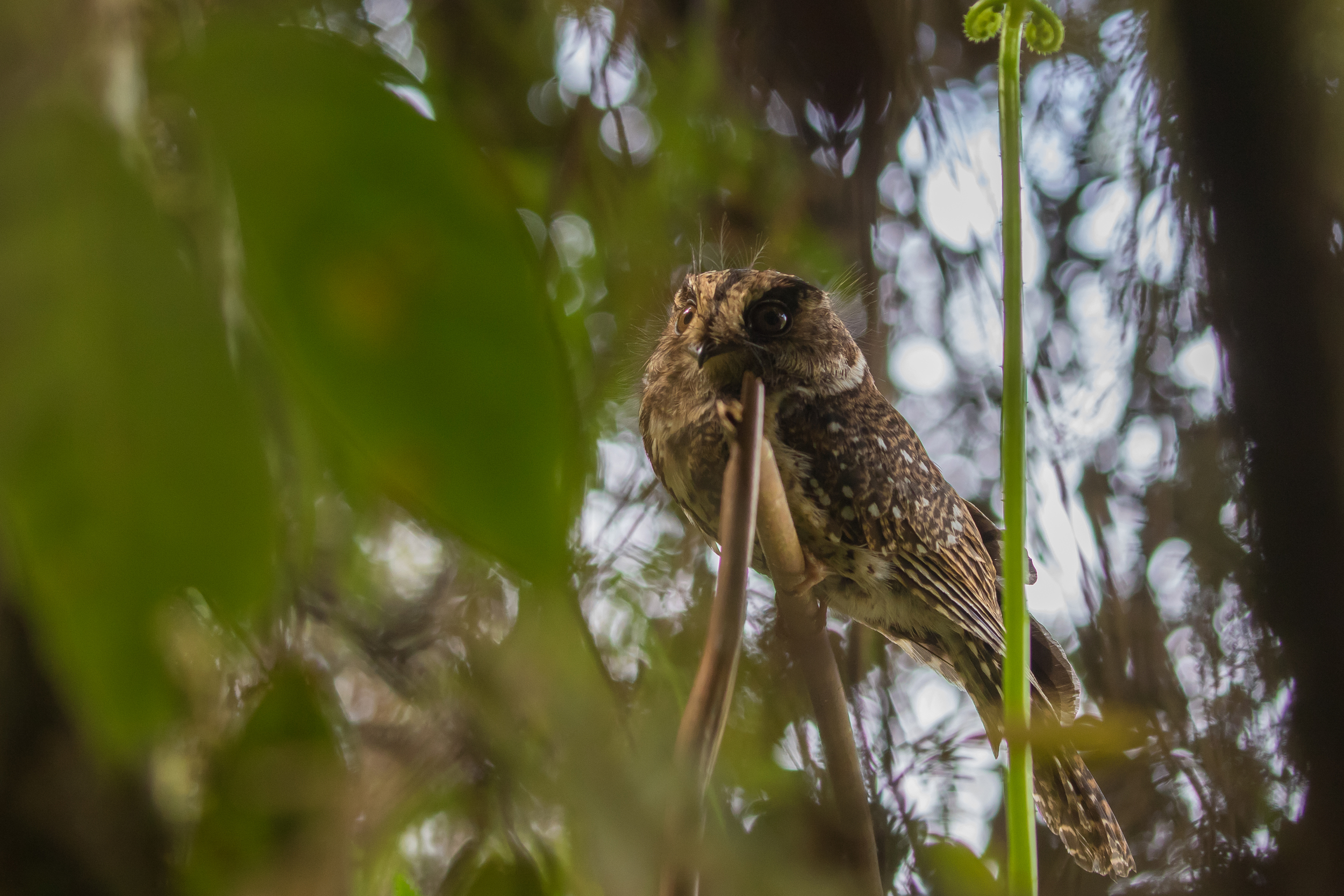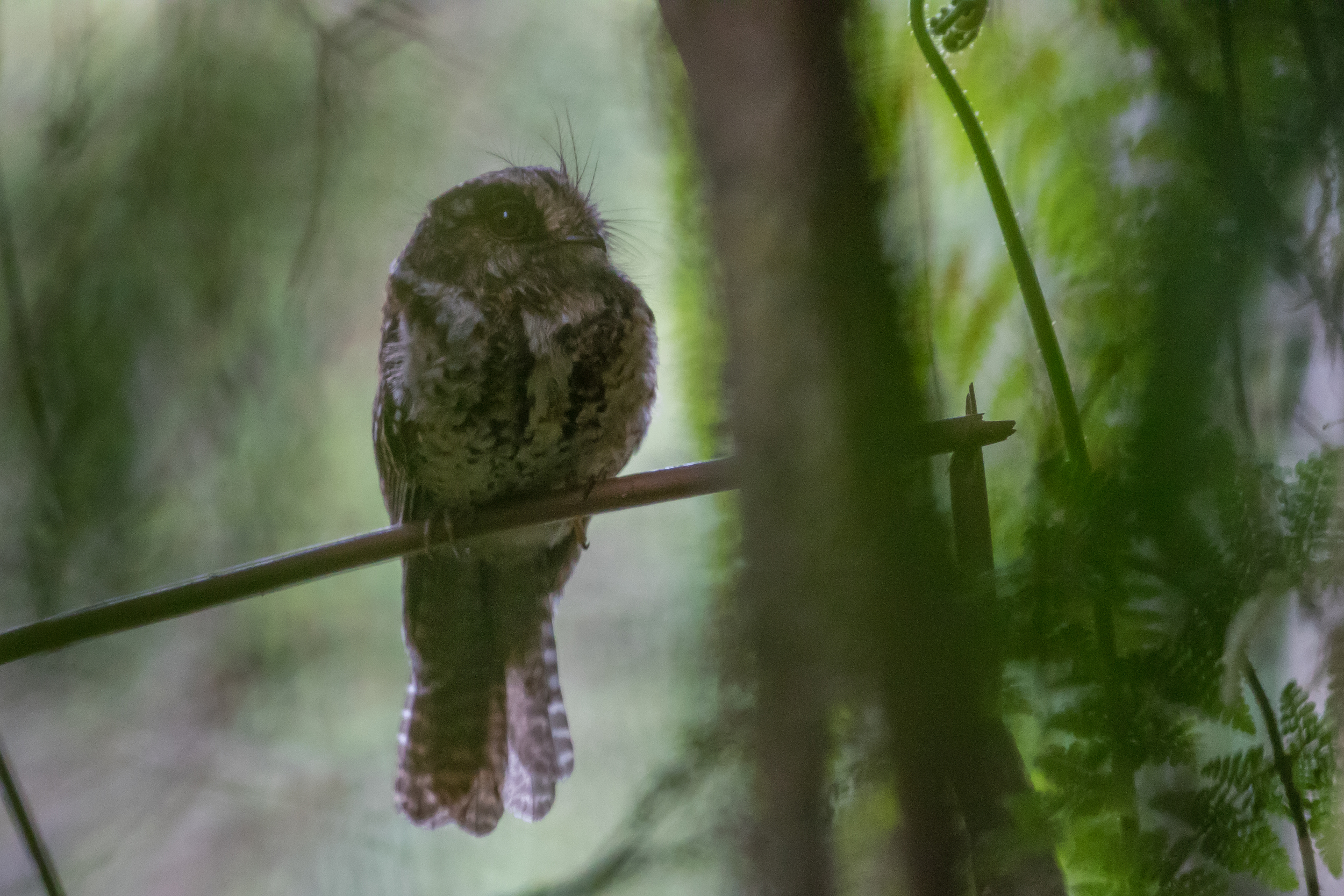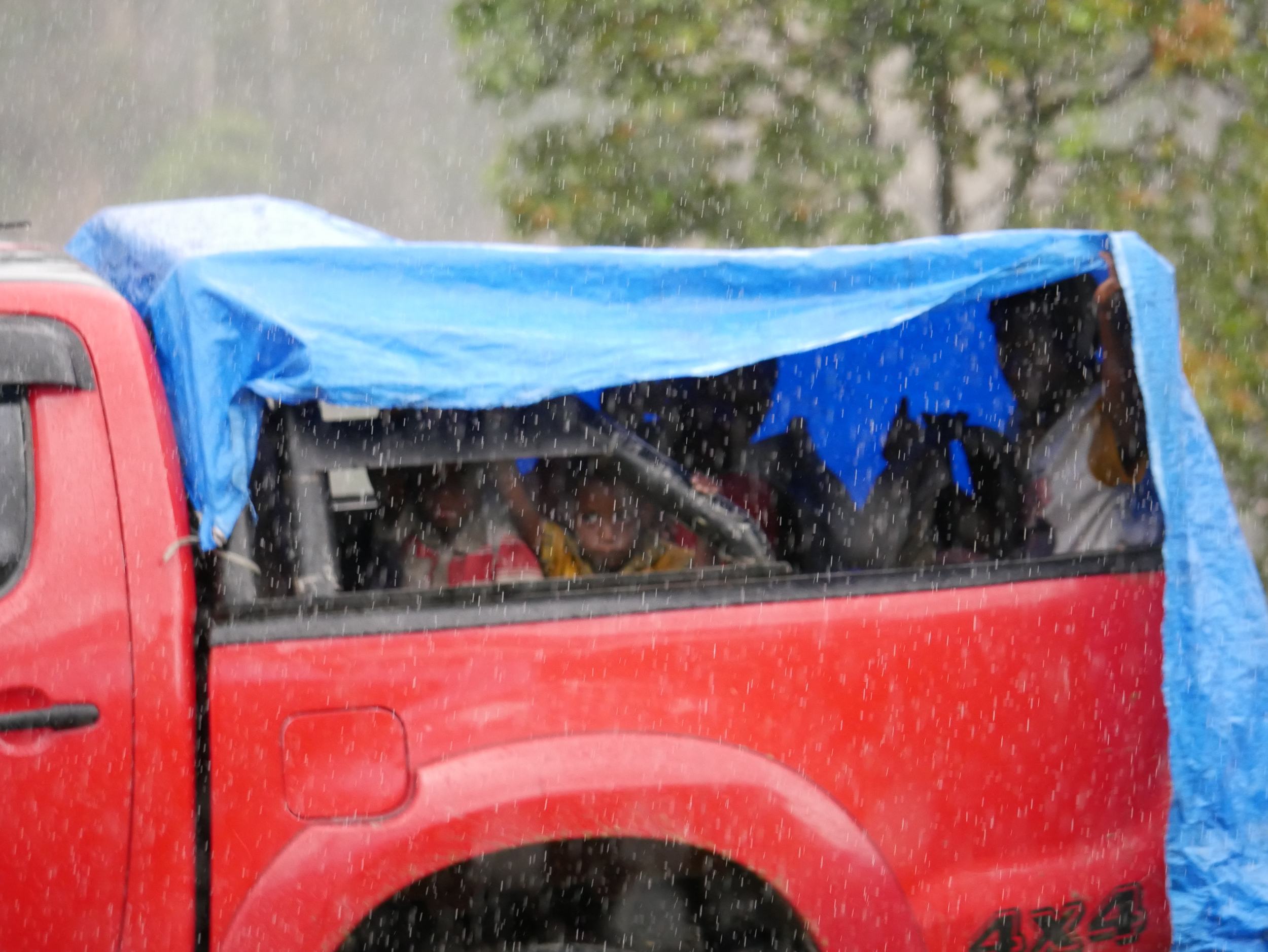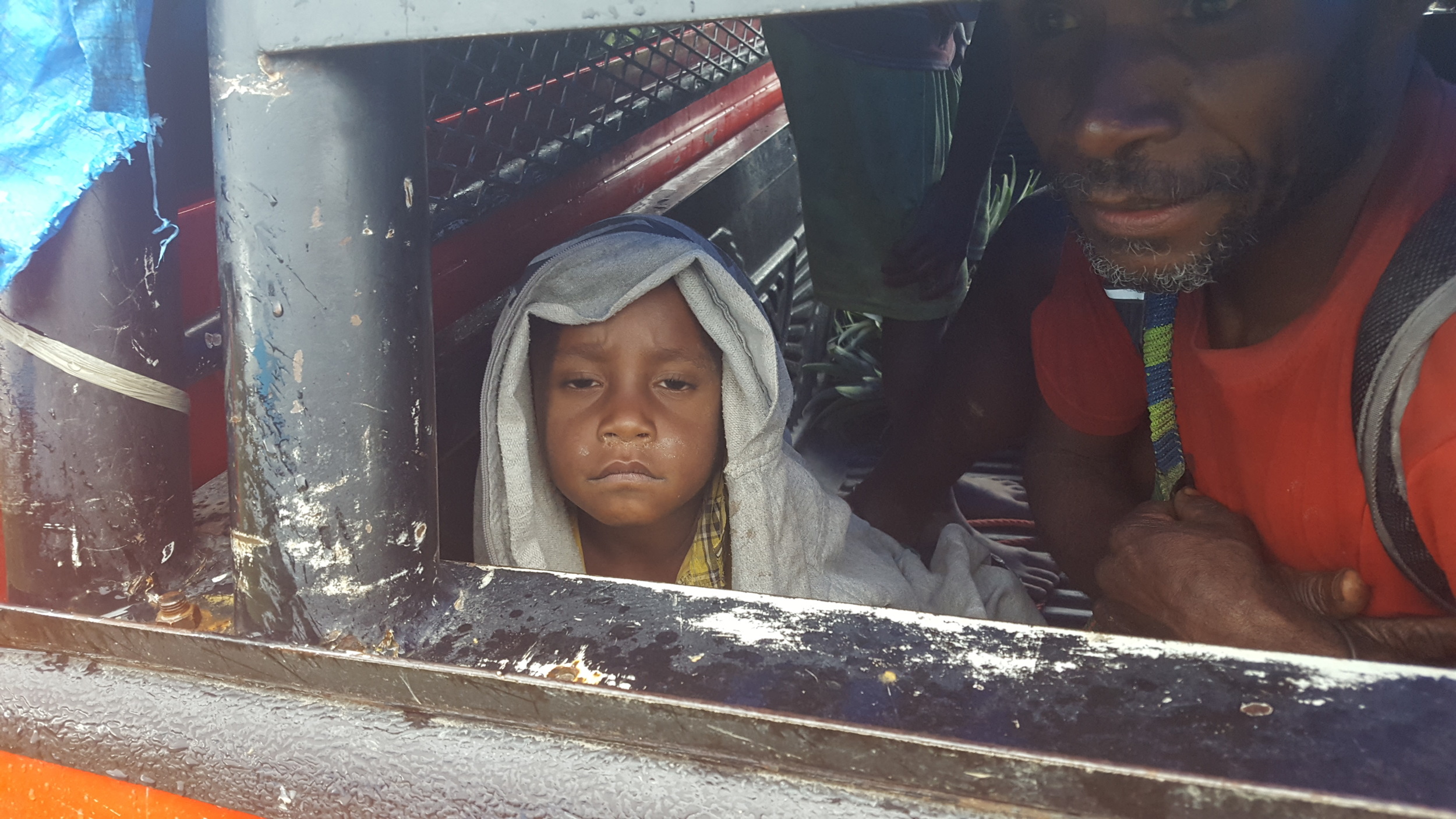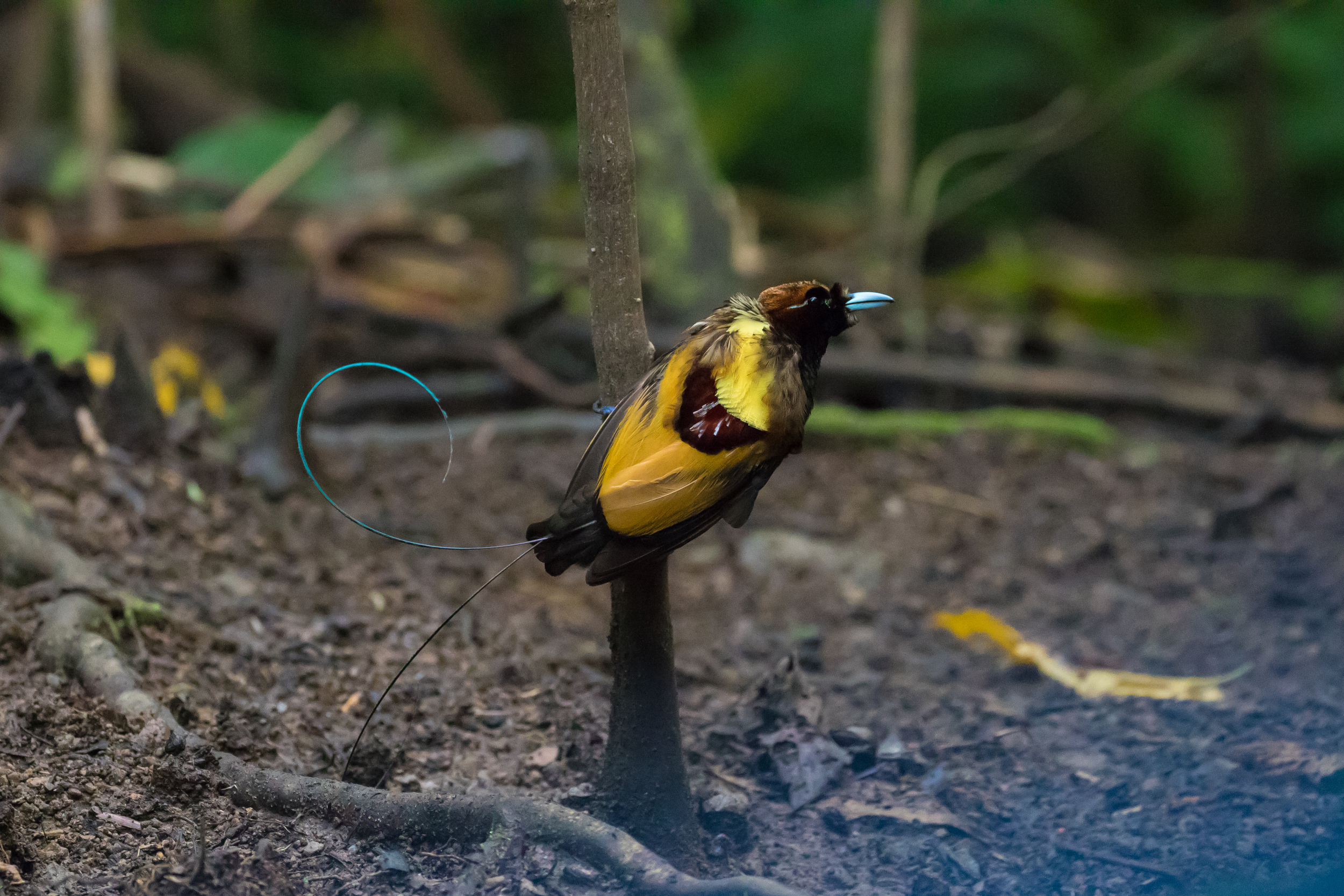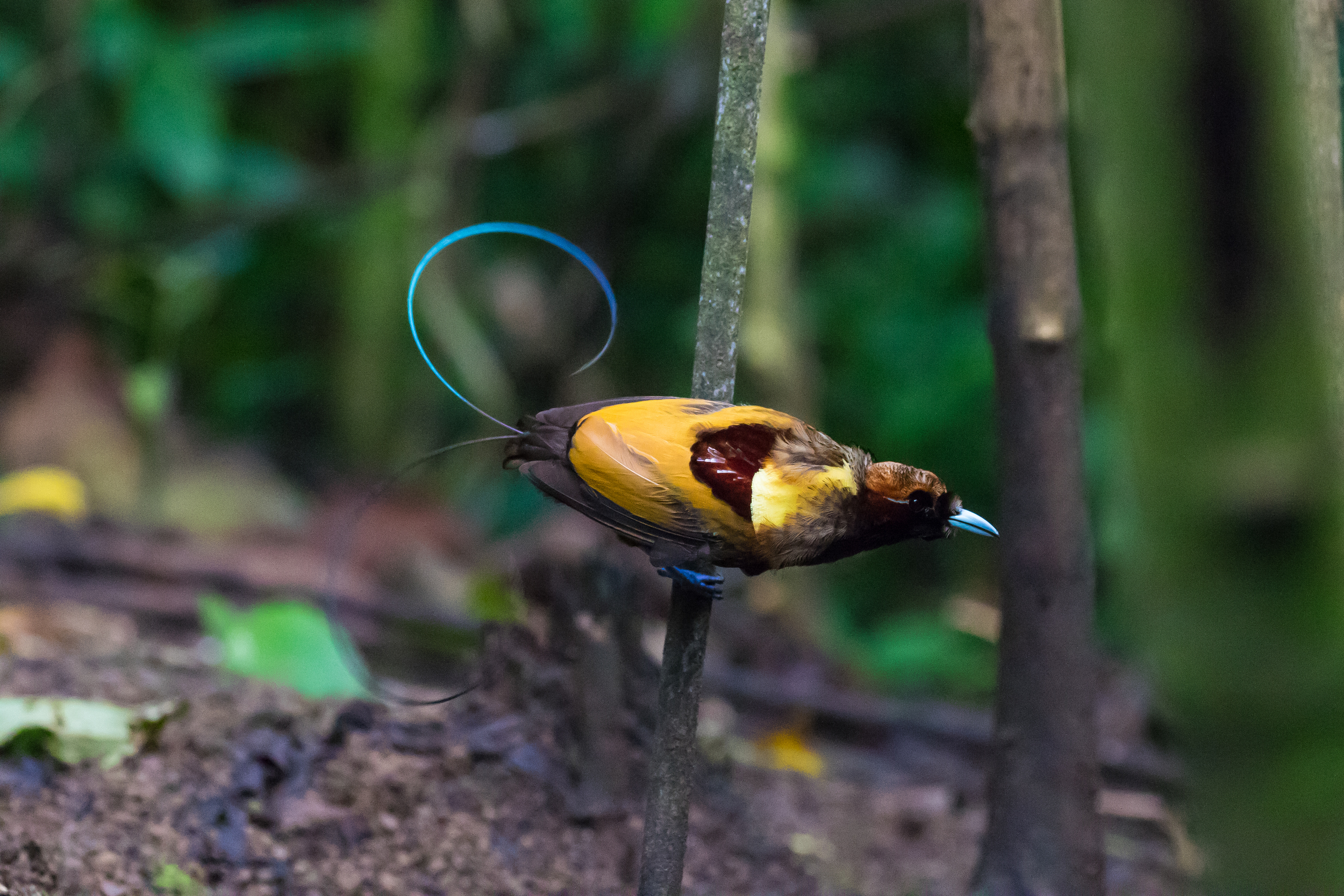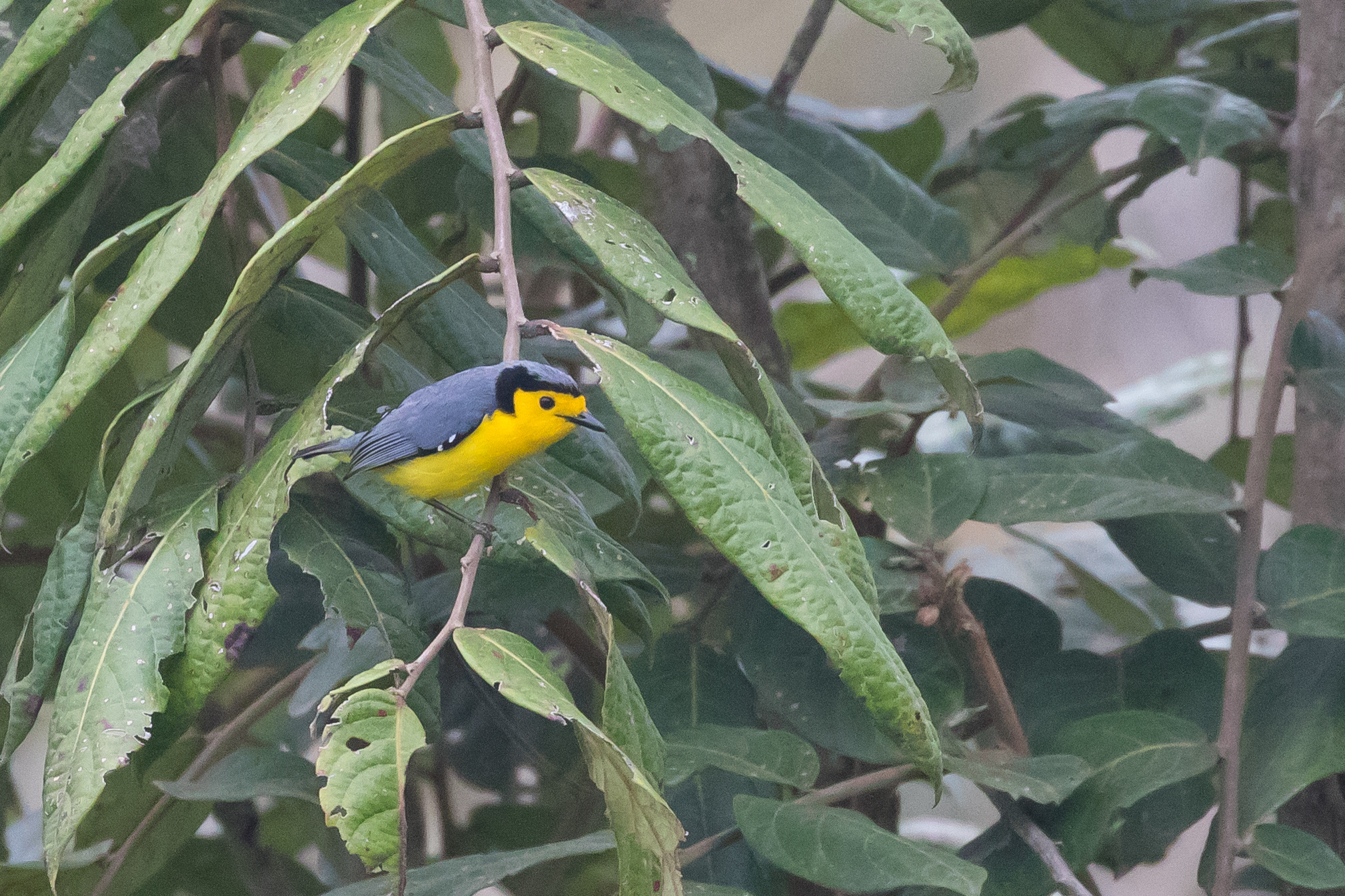Day 10, 21/7/18, “Arfak Mountains, here we come!”
Another day that is primarily travel. We are booked on the first flight from Sentani to Manokwari, though this doesn’t get us to Manokwari until late morning, at which point we will have a 3 hour drive up into the Arfaks. At least we have a lie in in the conmfortable HorEx beds. But guess who is on the same flight: our hearts collectively sink when we see the Ducking Futch at the airport.
On arrival in Manokwari, Shita is greeted by all and sundry – this is her home and it seems she knows almost everyone! The Arfaks are famously wet, and with clouds hanging over the mountains today, we load up the Hiluxes then our drivers and guides strap everything down tight under tarpaulins for the slow journey up the village of Mingre. Along the way we stop and Shita (from the other vehicle) produces our picnic lunch – she has thought of everything. We follow the coast initially before turning inland and soon afterwards we start a steep ascent. The road degrades abruptly into a 1-in-5 and even 1-in-4, deep-holed and rutted track, meaning 20km/h is pretty-much top pace.
The good news as we ascend, ultimately to 1500m a.s.l., is that the forest looks excellent, with wonderful big emergent trees, and much less sign of extensive logging than in either of the other places we’ve been.
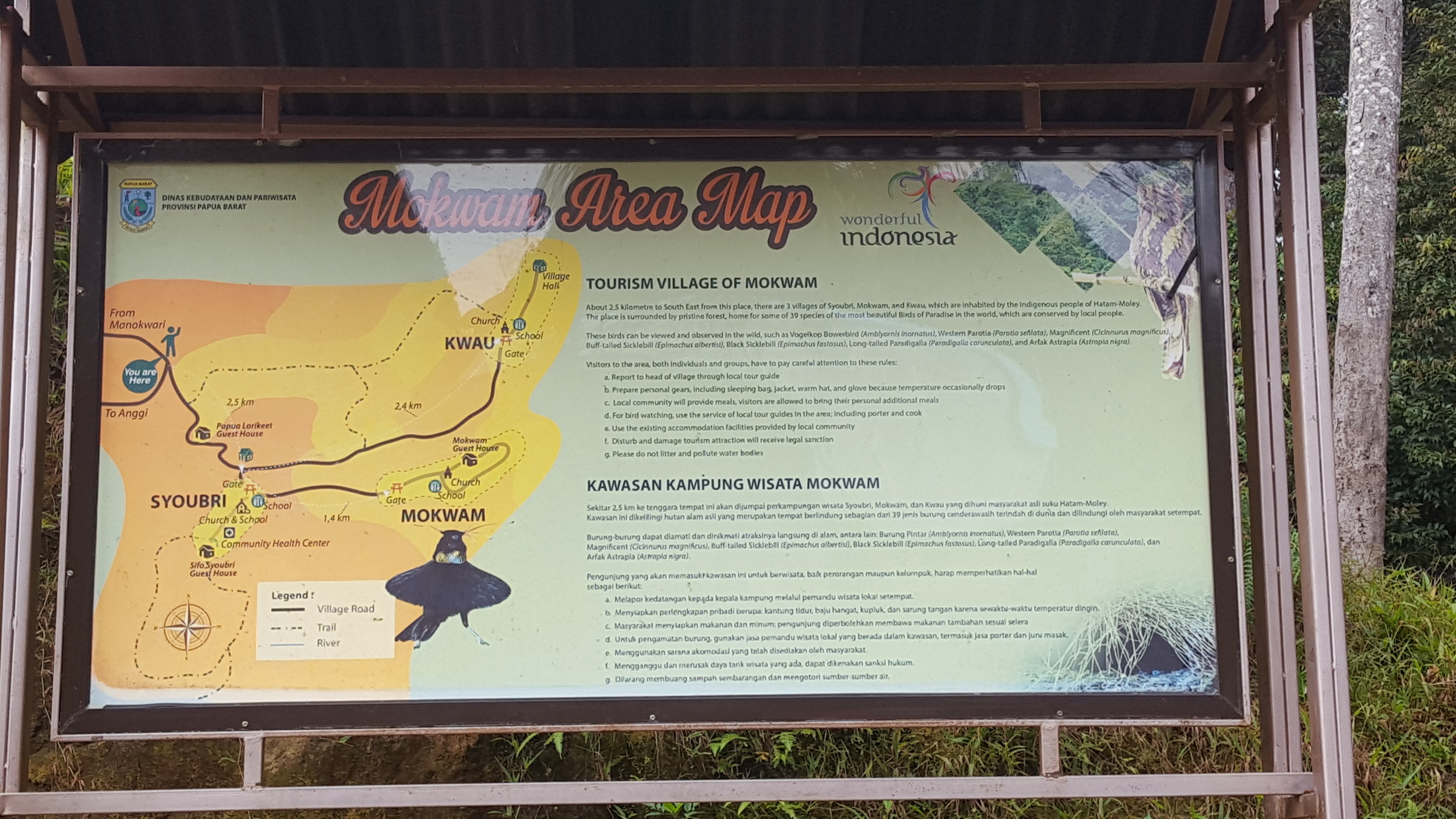
We arrive in the lovely village of Mingre where Shita has been coming with tour groups for the last few years (though not marked on the map above, it is basically where the “you are here” green man is). We will spend 3 or 4 days here, and 1 or 2 days up at a remote camp owned by Zeth Wonggor from Syoubri, the next village along the road. It is raining as we arrive, so after we have settled in we reconsider our plan to go to a local Magnificent Bird of Paradise hide, because the weather means this is probably a waste of time. A better plan, Benny and Shita suggest, might be to wait for the rain to stop, then drive the road looking for Masked Bowerbirds. These stunning birds like to sun themselves straight after rain. Well, it sounds like a plan!
While we wait, I sit on the verandah of the hut that will be Steve’s and my home for the next few days (Jon has his own hut 50m up the track) and scan the tree-tops opposite. We find an Island Leaf Warbler, then see another small bird. It takes a bit of detective work to make out what it is as it moves mostly obscured in dense foliage, but I gradually piece together that this a female Red-chested Pygmy Parrot.
The rain stops at about 3.30 and we load into the car and drive about 15mins down the road. Three Hiluxes (80% of the vehicles here are Toyota Hilux, 15% motorbikes and 5% Mitsubishi Triton) are parked up just below the next village and we realise the Ducking Futch are at the Mag BoP hide. Just as well we changed our plans because otherwise we’d have been in conflict with them again! We carry on another 500m then stop to scan.
Within seconds Jon announces he has the bird: some distance away, but shining like an orange beacon on a dead treetop, is a Masked Bowerbird. Our digi-scoped photos do not do justice to stonker which sits out proud sunning itself, pretty-much as predicted by the guides. Nearby a small flock of Papuan Mountain Pigeon are likewise sunning themselves to dry off. We spend quite a bit of time trying to get a Goldenface (old name, Dwarf Whistler) to cooperate. Steve and I had this in PNG in ’08 but it was a dip on Jon’s trip in ’03 so he is especially keen to see this cute new-world-warbler-like bird. Once again Jon sees various bits of bird while I don’t even see any movement in the canopy. I’m relieved I don’t need it! Fantailed Monarch is also new. It is also nice to see several Blyth’s Hornbills, a big and obvious indicator of forest health!
The villagers have once again prepared a marvellous meal for us using their basic eqipment, but we are again plunged into temperance because Manokwari, like Wamena is dry. Apparently the only place you can buy booze is the police station! A degree of Shadenfreude accompanies the news that the Dutch have dipped on the Mag BoP ;-).
When designing the trip, three birds stood out right from the very start as must see, and also must see well, displaying if possible: Western Parotia, Black Sicklebill and Wilson’s Bird of Paradise. See these well and the trip is more-or-less a success. Fail on any one and the trip is verging on disaster. Tomorrow will be our first crack at one of them, the Parotia, so we head to bed with great anticipation – and even some nervousness – of the following morning’s itinerary.
Day 11, 22/8/18, “The quest for the Big 3 begins.”
We drive down to a site not far below Mingre and then walk in the dark about 15mins down a steep slope, though we are now accustomed and this is nothing compared with the Ibele trail. What appears to be a dump of rubbish at first sight causes us to pause in our descent. Closer inspection reveals this is the bower of one of the Bird’s Head’s most famous resident species, Vogelkop Bowerbird. The maker of the bower is not yet in residence, but we see that this particular individual is fond of crisp packet wrappers, black fungus and black plastic, greeny-brown fruits and various other decorations.
We need to be in the Parotia hide before dawn so we do not stay long, and it turns out the hide we need is only another couple of minutes along the trail. Benny leaves the three of us to settle in to our “accommodation” at 5.50.
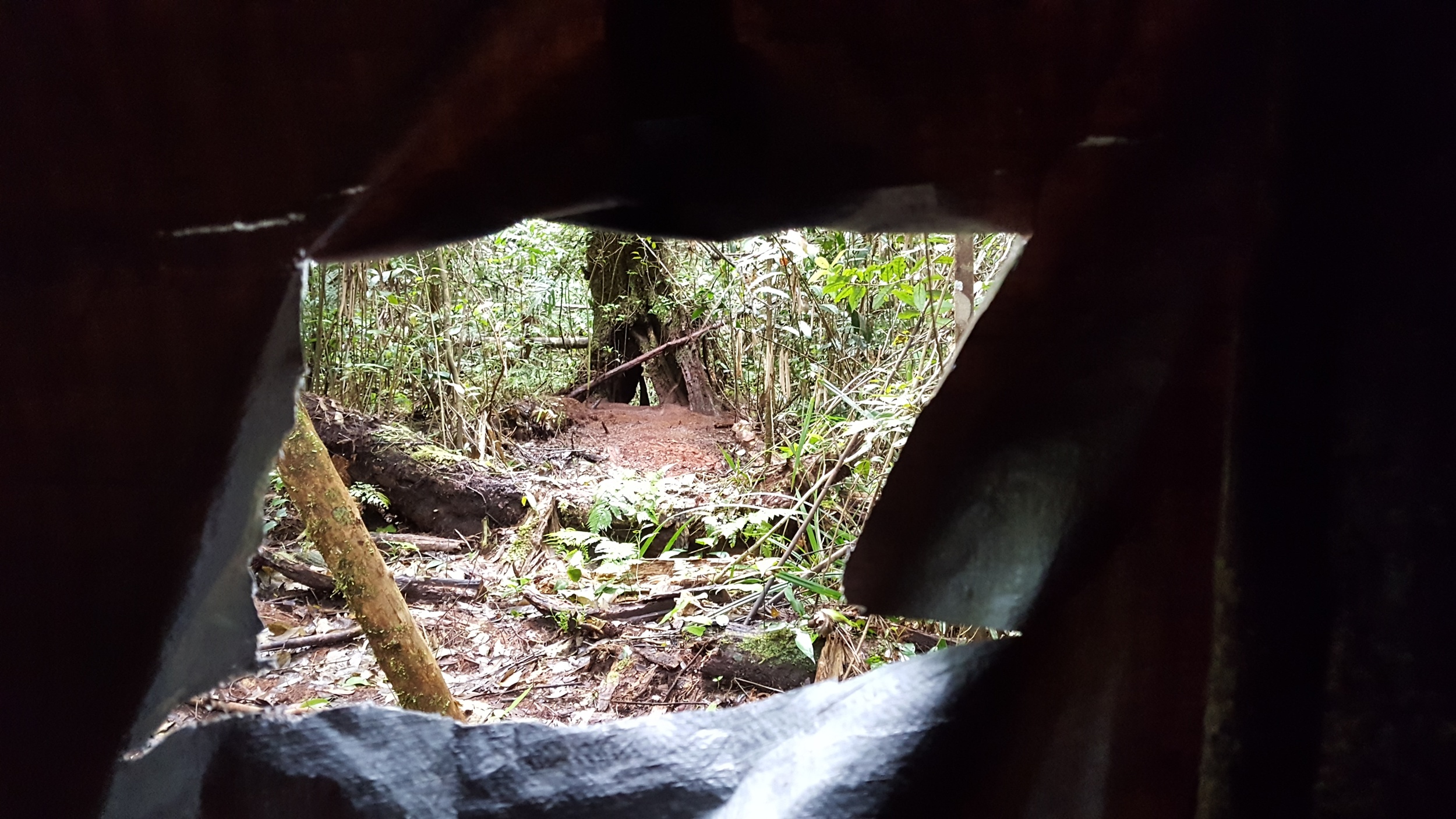
We wait for 15-20 minutes, during which time I can hear Black-billed Sicklebill’s beating whistle, so unlike most other BoP raucous cries and rasps. Fifteen to twenty minutes later, a large black bird lands on the cleared ground about 5m away: Western Parotia. We are too nervous to start taking pictures, and then it comes even closer, landing on branch a mere 2m away and staring straight at us. I am sure it knows we are here, and when cautiously I shift my position marginally – I swear noiselessly – seconds later it flies up and out of sight. Shit – have I just blown it? We sweat on its return and it keeps us in suspense. I have flashbacks to Mag BoP in the Huon when we had 5 seconds viewing of a bird that then disappeared never to be seen again. As we wait Steve indicates that the Black-billed Sicklebill we’ve been hearing is visible to our left. I crane my neck to see but can’t see anything at the spot he seems to be describing. After what feels like an age, but is probably only a few seconds, I realise that the spot is about 2 feet to the left, and by twisting my body even further I can see a B-B Sicklebill is at the base of the tree, looking up the trunk and calling.
The Parotia returns and once again inspects his display court, clearing a few leaves out of the way. Again we hope this is the prelude the full action. He seems set to go into a dance, but then again flicks up to the perch in front us. We collectively hold our breath and he goes back to the court. Now he sets his stance, legs astride, holds for a few seconds, gradually lifts his “skirt”, then like a ballerina tiptoes in a circle in front of the large trunk. He starts with his back to us but as he turns around the half circle he stops, flicks his shimmering gold necklace and dodges his neck back and forth like an Indian dancer, weird head plumes bouncing about as he agitates his head. Magic!



Over the next 2 hours a few females visit and he is periodically in attendance to repeat the performance as many as 9-10 times. We come to recognise the pattern of the performance, which is repeated each time. Eventually at 8.45 Benny comes back to get us and we leave the hide on a massive high. The first of the “Big 3” has performed brilliantly. My only regret afterwards is how dark the forest floor remained for the entire time, and the fact that I have failed to bring my tripod, so all my pictures are hand-held at fairly low shutter speeds.
We spend the rest of the morning birding the trails below Mingre, eventually returning to the village on foot. From 8.50 we observe various new birds including Black Fantail, Vogelkop Scrubwren, Black Pitohui, Pygmy Drongo and Sclater’s Whistler. We see a several female Parotias in the forest, but then observe another largish, dull, brown bird in a fruiting tree. This is neither a female Parotia nor female Black Pitohui – in fact this is our first of the non-descript but very special Vogelkop Bowerbird.
At 9.30 a high-pitched, thin call alerts us tithe fact that there is Spotted Jewel-babbler nearby. We spend maybe the next 30mins with this notoriuos skulker for pretty ordinary views. I see one briefly picking its way along the first floor but too oscrured even to seeth wing spots that give it its name. Steve and Jon get better views, especially when at one point two birds, excited by our playback and each others’ presence, chase each other around, briefly blowing their cover. I see the speedy movement but cannot land bins on either before they have taken off again. I tick it off mentally, but hope for better views over the next few days.
New birds continue as the morning draw on, with Mountain Fruit-dove fairly common, sweet Blue-grey Robin putting in an appearance and our first Arfak Honeyeaters (the Arfak version of Common Smoky from the Snow Mountains) which play hard-to-get but eventually give decent views. Another desirable species here is White-striped Forest Rail. Our experience with Chestnut F-R on the Ibele Trail has made me nervous of this species and this morning we have no luck. The first site we try immediately elicits a response. I raise my bins to my eyes to grill a small dark body rushing directly towards our speaker, only to see a small rat-like creature running over, presumably in the expectation of an easy meal. Wisely, no real Forest Rails are in attendance. At another site we have a half-hearted response but completely contrary to the guides’ expectation, no bird appears and it goes completely silent.
As we walk back the village for lunch we add Friendly Fantail, a cute Papuan Flycatcher (Flyrobin), and Papuan Treecreeper to the morning’s list. We miss a few birds that go down as heard only – some because they are unresponsive, some because they are tricky – Vogelkop Melidectes (much less conspicuous than its counterpart in the Snow Mountains, Belford’s), Vogelkop Whistler, and Ashy Robin. But at this stage, on our first morning, we are pretty relaxed.
After lunch the locals take us down to one of the unoccupied huts at the bottom of the village. We enter cautiously and peer up into the rafters following our guide’s gaze. There staring wide-eyed down at us is a stunningly gorgeous Mountain Owlet-Nightjar.

At 3.30 we head down the road in the car again, hoping for closer views of Masked Bowerbird and maybe some other, slightly lower species. We see nothing new, missing a close Bowerbird found by one of the locals, but which flies before we can join him. We add Little Shrikethrush, and see a couple of Lesser Bird of Paradise including a fabulous male.
After dinner, Jon heads off to bed, too tired (or perhaps lacking the confidence in our ability) to come owling. I gather speaker, flash and new wolf-eyes torch and we walk down the the bottom of the village. Standing next to the ONJ hut I play Greater Sooty Owl’s falling bomb whistle. I am not hugely expectant so I am amazed when a big shape drifts over the large tree in front of us. Steve, perhaps trying to convince himself not to get excited, says he thinks it is a fruit bat. I am not so sure and scan the branches of the tree in the torchlight – I see eyeshine. I keep the torch steady and Steve is able to confirm that high above us, a superb Sooty Owl has landed and is checking us out. I struggle with torch and bins, unable to get both pointing at the same location until Steve takes the torch so I can get a better view. The owl, probably unhappy about the waving torch, takes off and lands in denser stuff at the back of the tree, though now agitated and uttering the insect-like territorial call. We try to coax it out with some more playback but it stays put. I realise I have a third call on my Australian Birds app, and play the threat screech. Instantly it is back on the wing gliding over our heads. We watch it fly in the torchlight until our view is washed out by the torch relecting a dense spider-web just behind us. It continues to call for some time, but we leave it in peace, well satisfied with our night-bird haul for the day.
Day 12, 23/7/18, “Stairway to heaven”
At 6am we load ourselves and our kit for an overnight stay (or two) and drive a short way to the village of Syoubri. There Benny and Shita leave us with Zeth Wonggor, well known as one of the first to realise the opportunities for eco-tourism in the Arfaks. He has been guiding and hosting birders here for 24 years.
In beautiful sunshine (for once!) we bird along a trail the leads up a steep valley away from Syoubri. We spend the next 2 hours walking and birding slowly, picking up some nice new targets along the way. After giving us the run-around yesterday and earlier today we finally get decent views of Vogelkop Melidectes, and another morning highlight is the sweet Garnet Robin. In addition we’ve added Grey-green and Perplexing Scrubwrens, and Spotted and Mid-Mountain Berrypeckers and Papuan Sittella. As we get higher we also have our first (brief) views of Mountain Mouse-warbler and Papuan Sitella. Mottled Berryhunter calls but is heard-only (I will regret this when I return home and realise Rhagologus is a monotypic family. A much desired bird here is Vogelkop Superb Bird of Paradise. We find a male in fruiting trees that shows briefly, but a female shows much better. Zeth tells us not far away there is a Superb BoP display court, and if we hear the excited calls, this could be a sign to head to the hide he has constructed overlooking the male’s favourite moss-covered log. Indeed for an hour between 9.30 and 10.30 we sit in the hide hoping, but we are out of luck, though a Mountain Mouse-warbler hops onto the log at one point.
When not in the hide, we hang around a clearing not far away. A non-birding highlight of the morning comes when one of the porters disappears momentarily, returning with several wild passionfruit which are delicious! But the reason we are loitering here is that we hope for one of the rarest and most elusive – if also least interestingly plumaged – birds of paradise, Long-tailed Paradigala. A nest near here is sadly not occupied otherwise we might have had an easy tick. Instead we spend a very frustrating 4 hours here hoping one will come to the fruiting trees. There is a surprising amount of bird activity, but it is almost all from a very active flock of Red-collared Myzomela that are feeding and chasing one another incessantly. We see a few bigger birds in the fruiting trees, but each time it turns out to be a female Western Parotia – we see five by the time we move on. At around midday as we have a picnic lunch one of the porters excitedly announces Paradigala and we all strain to get on it high in the canopy. Jon and Steve see a tickable but underwhelming silhouette, but I see noting satisfactory, and all too soon it slips out of sight and we can’t relocate it.
We find a few more nice birds before we move on including Orange-crowned Fairywren and a lovely roosting Mountain Owlet-nightjar. Apparently there was a Feline regularly roosting nearby also until it was flushed by a previous tour group. Grrr!
The next 1.5 hours are spent on a strenuous climb up to the campsite. It is not very muddy, but the trail is the steepest we have been on, at times feeling like it is almost vertical. I am grateful for all the cycling up Mt Lofty I did before the trip that have put some strength and endurance into my legs.
We arrive at a pretty basic camp where porters have already delivered food and our bagged-up clothes, sleeping bag and other miscellaneous gear. With “beds” set up, we grab a cup of tea then from 3.45 we go out with Zeth to explore. It is wonderful to be birding in high quality primary forest and we pause for selfies under some of the huge buttressed emergent trees. Ashy Robin and Regent Whistler are new additions and we have a very nice encounter with a Lesser Ground Robin.
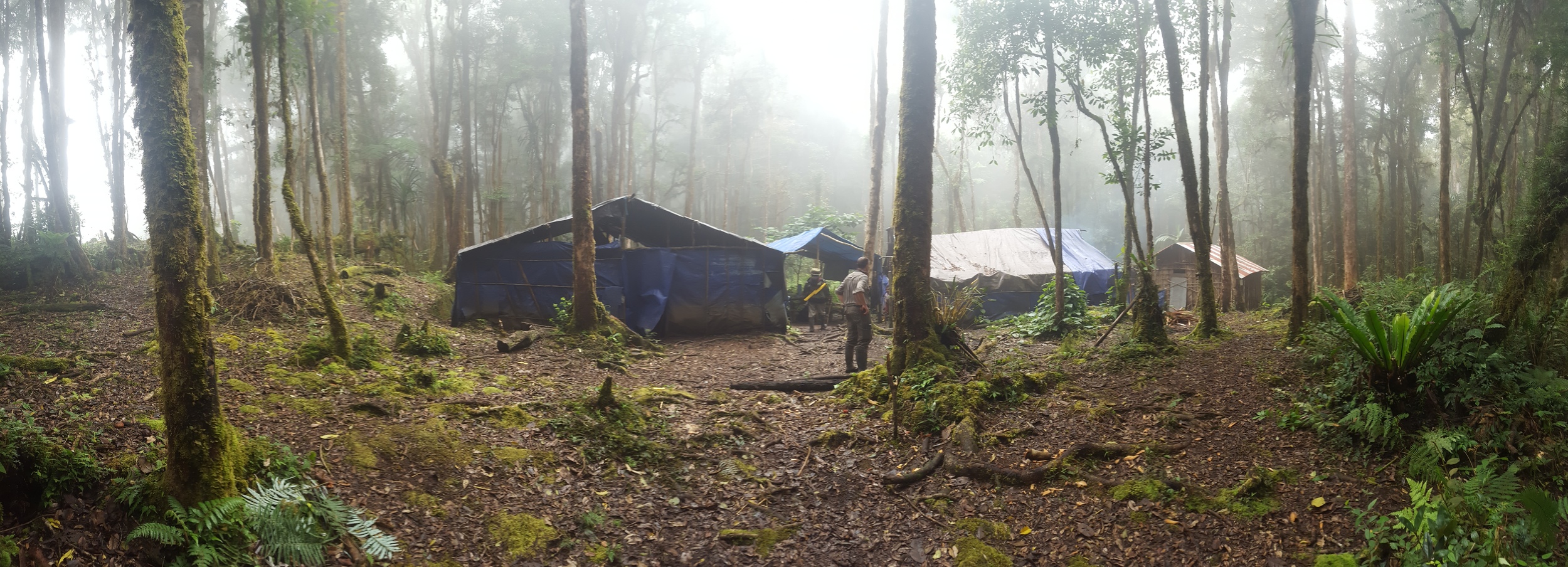
At one point Zeth points out an amazing bower of a Vogelkop Bowerbird. This one has a couple of hides set up opposite and we learn it is one a two that are being monitored and filmed by a Korean film crew making a documentary. Not far beyond the bower we hear an amazing call, like a storm-trooper laser gun, and we stop in our tracks – the second of the Big 3, Black Sicklebill. We are hoping to visit a display post tomorrow, but of course we follow the sound and track down an utterly superb male Black Sicklebill.


We carry on birding even as it is getting darker, continuing to find some goodies. We finally get tickable views of Cinnamon-browed Melidectes, find a Dimorphic Fantail and after longish chase get good looks at a couple of Black-throated Robin just before we lose most of the light.
After dinner, prepared over a campfire by our porters, I persuade Steve and Jon we should do some spotlighting. A Papuan Boobook calls from close to the camp and we work hard to get a look at this endemic Ninox. With that in the bag, as we walk back to the camp I play the call of Feline Owlet-nightjar. Staggeringly, it is answered immediately and it is very close to the camp. We try hard to find it but are struggling, even though it calls again once or twice. Zeth arrives and when it calls again he is immediately on the case – presumably more accustomed to its habits, he points the torch along a trail leading away for the camp and I hear Steve exclaim that he has the bird. I line up behind him and look in the direction of the torch-beam but can’t pick it up. “You’re looking too far away — it’s just there, right in front”. I lower my gaze and wow! The bird is on a post barely 5m away, looking straight at us. It poses brilliantly and even the porters come out with mobile phones to get pictures. One of non-BoP highlights of the whole trip and all the sweeter for the team effort involved in finding it. We leave the ONJ in peace, but before we get to bed movement in the canopy attracts the attention of the locals. We point torches upwards and 15m above us a cuscus is wandering about looking for fruit.


Tonight will not go down as one of the more comfortable or restful sleeps in the trip. Our raised cane beds are hard and bumpy (even when supplemented with thin portable air-mattresses), they are not even horizontal so we slide down during the night, and it is very cold! At least we have had another cracking day birding.
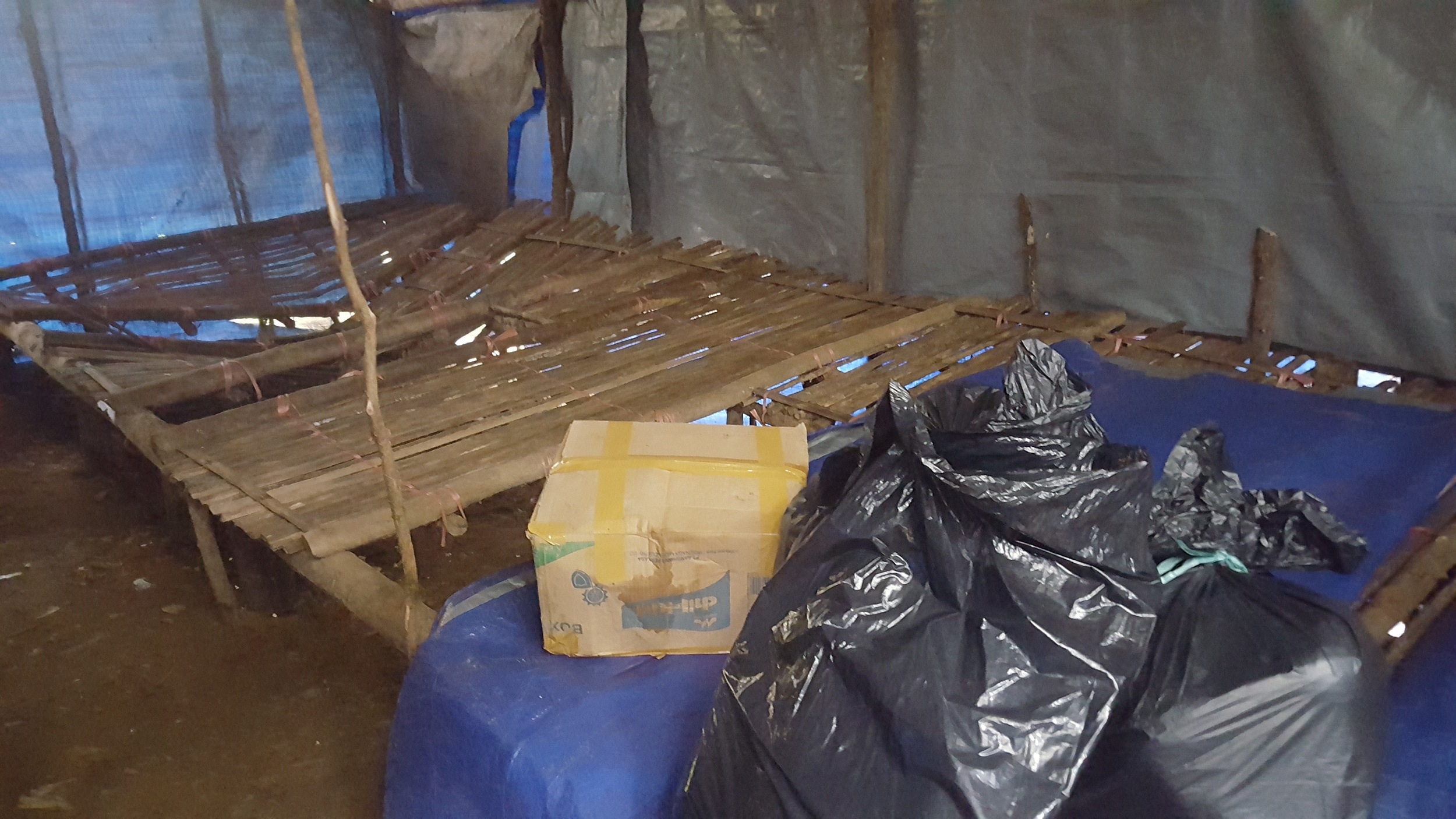
Day 13, 24/7/17, “The highlights reel grows”
Today – or first thing in the morning at least – is all about one bird, Black Sicklebill. The second of the big three has loomed large in our thoughts since day one of planning. We saw it yesterday, and it’s not even a lifer for Jon, but for we still want the intimacy of a dawn display experience. Inevitably then, we are up pre-dawn. It has rained pretty-much all night and is still drizzling as we rise, but mercifully as we set out at 5am for a 30min walk along the forest trails to the display post and Zeth’s hides the rain eases, then stops.
We end up in 3 separate hides, one of us in each, though all with basically the same view. I ready my equipment, meter the light on the display post, and we wait.
Mindful of the difficulties of getting decent pictures while handholding a heavy camera and lens at low shutter-speed, high ISO, I have also brought my tripod. Indeed I might as well use the tripod for photography because one of the porters has been a bit too haphazard in his handling of my scope yesterday, and the thread on scope’s tripod mount has been stripped out, rendering the scope itself virtually useless. First trial pictures just before 6am reveal just how dark it is: even at 6400ISO and maximum aperture, I can only get 0.6sec exposure!
It will gradually get lighter – though never much – but it is still very dark when, very soon afterwards we hear that amazing call, almost directly over our heads. It is so forceful, so loud, and so close, that I almost jump out of my skin. It calls again a few times, each time sending shivers of anticipation down the spine, and then finally at 6.15 a dark shape with an unfeasibly long tail bounds across the clearing and lands on the top of the post where our optics are trained. Black Sicklebill. I can barely fit the whole bird in my frame, so far down the post (about a metre) does the ridiculous tail dangle. Yesterday’s views were either misty or silhouetted (or both), so only now for the first time do I see the satin sheen to its plumage, brilliant splodge of iridescent blue on its back, and small but bright blue spot behind its eye. As it sits, it preens and holds its epaulettes feathers that look a bit like stunted wings but whose only use is in display – away from its body like to resemble some dark, demonic, crucifix. Once or twice it lifts the epaulettes over its head, like a dark hood and transforms its shape into a weird, totally unbird-like spoon.




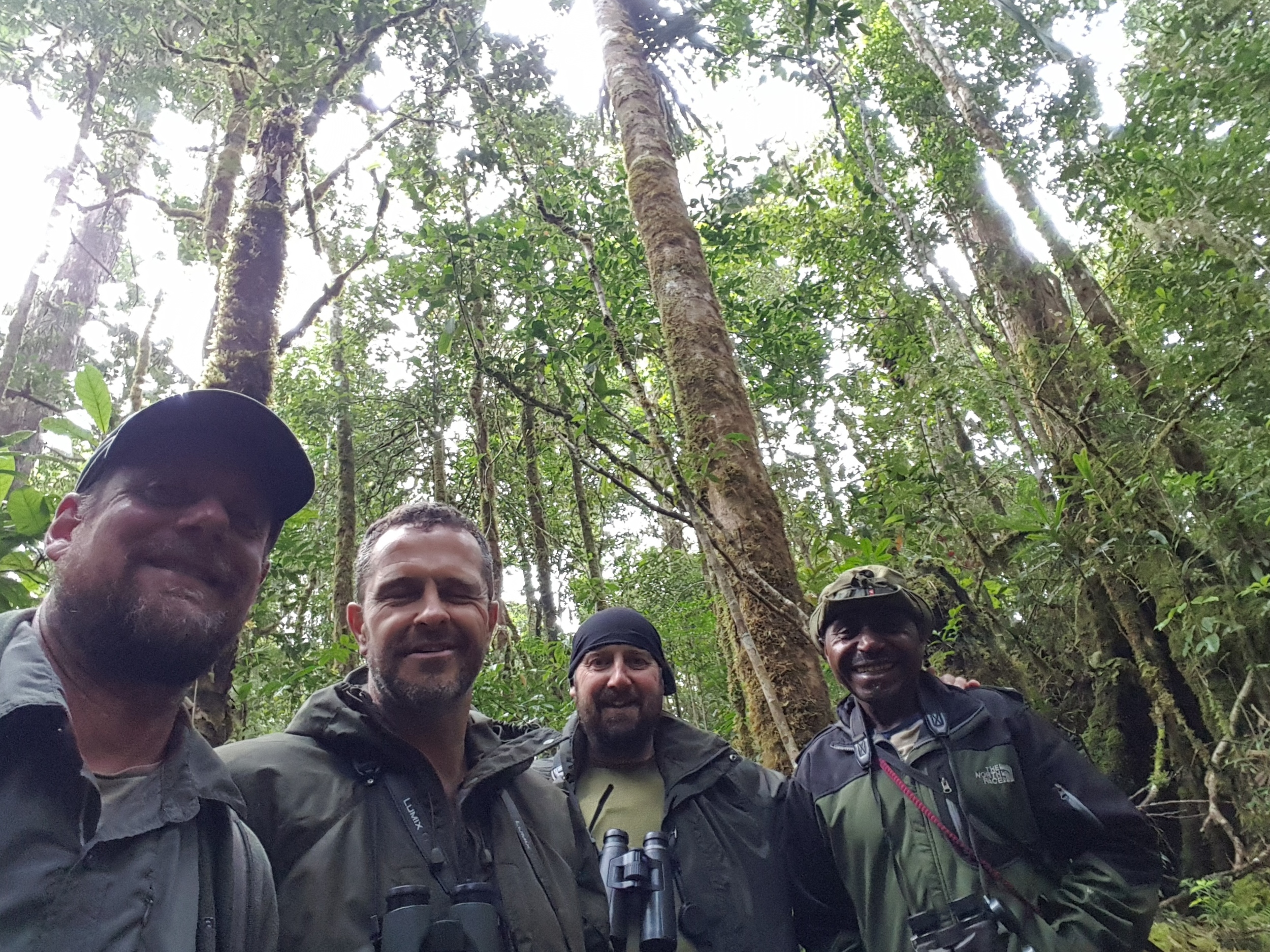
Sadly it is present only for 15 minutes, then flies off. A Mountain Mouse-warbler appears outside my hide providing a brief distraction but it is apparently that the Sicklebill is not coming back. Zeth appears at my hide and beckons, so I follow at pace. He has located it again, this time on an exposed branch. It is a bit further away and we must view through a narrow window in the vegetation. Zeth explains it often goes to this spot – it has probably decided that the forest was too dark this morning and will display out in the sun instead.
It flies again and we track for some minutes, including when it lands meters above our heads in a palm and clambers about looking for it favourite fruit. We celebrate, then carry on birding – what else would expect us to do? – we find a Black Pitohui and another Cinnamon-browed Melidectes.
We return to the camp then follow a trail in the opposite direction that takes us higher still up the mountain. Between 8 and 9 we see Ashy Robin, Black Fantail, Papuan Flyrobin (Flycatcher) and a couple of Black-throated Robins, including an immature bird that throws us for a bit – unlike the adults the imm has a rufous throat! Close 9am Zeth indicates we are reaching the lower altitude where Arfak Astrapia can be found. A few minutes later we stop close to a clearing but we are still somewhat strung out on the trail. Suddenly Augustus, one of our porters excitedly bursts out: Harpy! We all turn but he is at the back of the group, pointing behind. Jon (and maybe Steve), right next to Augustus, turns just in time to see a huge-winged raptor fly away through the forest. I follow long enough to see the shape of a massive bird for a few seconds drift out beyond the trees to an open valley before losing it to view. Another one gets away.
Minutes later, same spot, more excitement! Has the Harpy come back? No, it’s an Arfak Astrapia. This immature male behaves much better than the Eagle, giving us excellent views for a few minutes as it feeds on fruit and picks at moss covered branches. We will not encounter an adult, but then few birders do – they are gradually getting scarcer and scarcer, perhaps being outcompeted by Black Sicklebill which Zeth says are swelling their numbers in this area year by year. This bird is eminently missable and we know that other groups have struggled a lot to get it so we are relieved to have it in the bag by mid-morning of our first day up here.
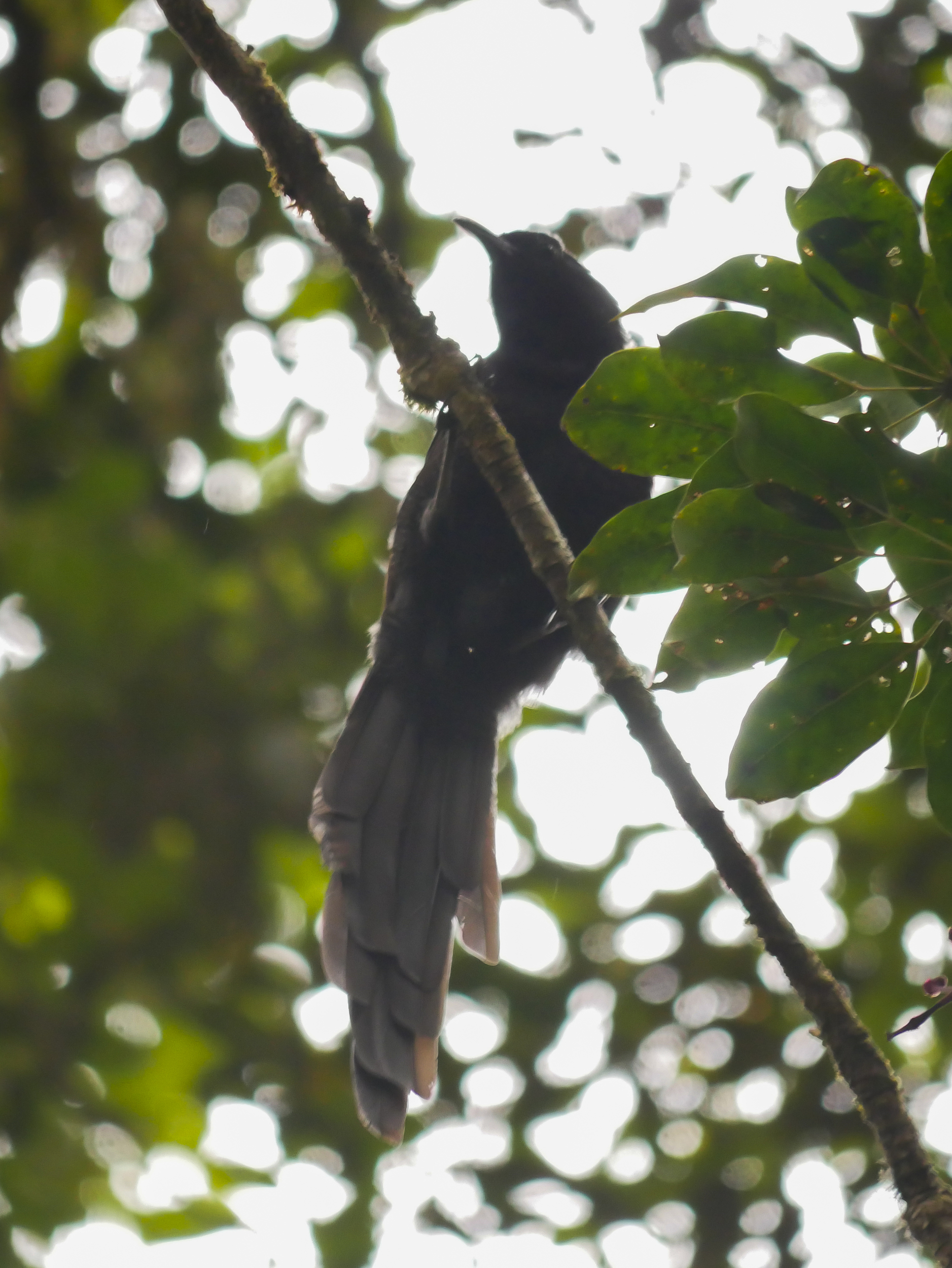
We also have a very brief encounter with Spotted Jewel Babbler here, but about 40mins later we find some more and I finally get the kind of views I have wanted. I have realised that playing the high-pitched alarm call gets the birds excited, and they fly rapidly around making them exceedingly hard to get onto. However I discover that I have also downloaded a softer contact call; playing this keeps the birds interested and they approach much closer, picking at the ground feeding as they sidle their way through the undergrowth. I wish I had worked this out earlier.
At the highest point we will reach we spend time at the bower of a Vogelkop Bowerbird. He has a lovely array of small blue berries topped by a plastic blue water bottle. Elsewhere he has collected some of the black fungus we’ve seen at other bowers, and unlike the others, he has also decorated a fallen moss-covered log with small piles of orange and red berries. We can hear he is close by so we retreat from the bower a few metres behind the log and try to make ourselves inconspicuous, though there is no hide here. He circles our group, and the way he is behaving he clearly knows we are here – but he never actually comes to the bower.
We retrace our path to the camp, about 40 mins away. We hear a few groups of parrots along the way, though getting onto these proves difficult as they feed in tree tops calling to one another to stay in contact. We have a nice encounter with some Plum-face Lorikeets, and get decent views of our first Papuan Lorikeets and find a few Tit Berrypeckers, both male and female which look quite different and a Fan-tailed Berrypecker. Back at the eagle clearing, suddenly the dry goes up “Harpy” again. Adrenaline surges and we look up — soaring above us is a huge eagle. Sadly the jizz is all wrong, and the bird is soaring, which NG Harpy rarely do. It’s an Aquila – Gurney’s Eagle. Immediately those of us who didn’t see the earlier bird wonder if the first bird was also Gurney’s, but we are assured by Jon that this is a different beast.
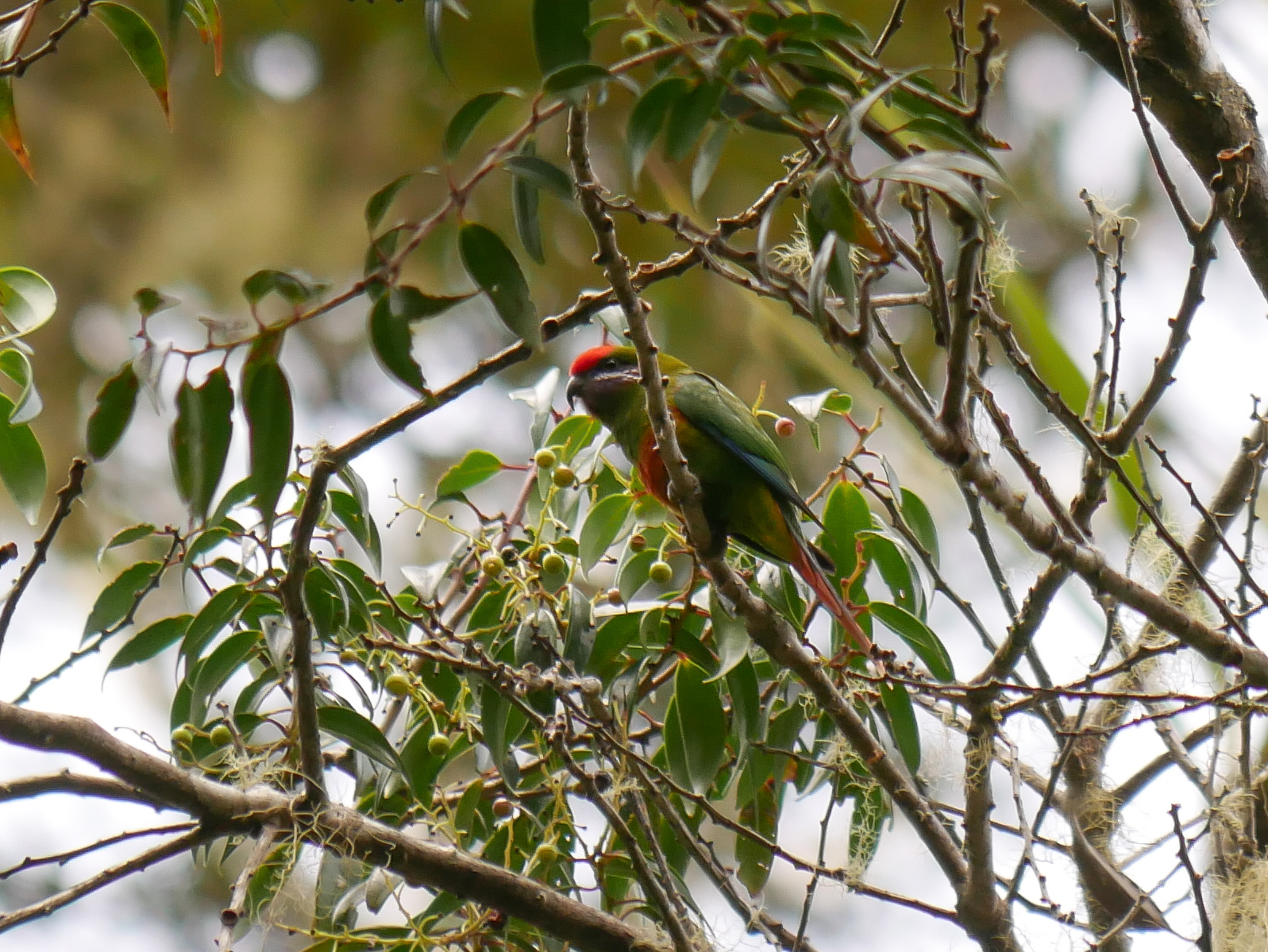
We arrive back at camp having pretty-much cleaned up our targets up here, so we are faced with a choice – break camp and hussle down the mountain during the least birdy hours of the day, and spend the night in relative comfort down in our Mingre huts, or stay here one more night, revisit the Black Sicklebill hides first thing, then have a more “leisurely” walk down to Syoubri at a better time for birds. We settle for the latter and let Shita now that we’ll stay up here one more night (even up here, there is some limited mobile signal).
So now we need to decide on the afternoon’s activity. I am keen to get better views of, and possibly observe a bowerbird tending its bower. Zeth negotiates with the film crew and they tell us their second hide will be empty this afternoon and we are welcome to use it. Sorted!
At 14.30 we settle into a hide that overlooks yet another bower, the fourth we have seen as we walked trails over the last 3 days. This bird, perhaps because of its proximity to the camp, has a large collection of blue plastic bottle tops, and seems to have a predilection for colourful flat things that it has meticulously spread out. It has also acquired huge stash of blue binding tape, again probably pilfered from the camp. Again we wait. And wait some more. It’s dull, but then there’s little FOMO – fear of missing out – because we’ve seen our targets already. 90 long minutes later it has started to rain gently, but a bird appears and we collectively hold our breath; we hope it will tend the decorations and remove some leaves we strategically scattered.
Instead we get more than we bargained for. The next 20mins are yet another amazing point in a long highlight reel from the trip. Initially the Vogelkop Bowerbird does not stay long and disappears into the forest. We brace for disappointment. But minutes later it reappears with a female in tow and begins a vocal performance to rival the visual displays we’ve seen from the BoPs. He flies into the bower and uses it as an echo chamber, initially at the back out of sight, but then he moves closer to the edge next to his prize “jewels” – we can just make him out under the canopy – then he peers out from under the lip. He starts with wheezing and grunting like a pig, then various mimicry of other birds — gentle contact calls, louder tweets, and some song – and then he transitions into a repeated series of weird, beating, electronic noises like a radio being tuned, or a hissing alien (whatever that sounds like 😉, punctuated occasionally by an amazing noise that we can’t work out if it is rushing air on beating wings or his impression of the same. At times it sounds like he is making 3 or 4 different vocalisations at once. The frenzied female flies back and forth to the bower maybe trying to work out where he is while he plays hard to get deep inside the bower.
The forest is dark, so I decide just to enjoy the show rather than be distracted by photography, but Steve has grabbed some fabulous video, which even if the shot goes in and out of focus and the bird is pretty drab, is still spectacular.
Eventually they both fly off into the forest and we reflect on yet another diamond moment. It is now raining quite heavily so we decide we might as well wait here in the shelter of the hide. Zeth was going to come and get us, but has not, so we hope and expect he is thinking the same. After another hour, during which time we amuse ourselves with word games, the rain abates, Zeth arrives and we troop back to the camp. It is just as well he does come for us, because I have become disorientated and would no doubt have taken a wrong turn on the way back.
Once back at the camp we relate our experience and are shocked – and maybe even perversely amused – to discover that the film crew have been here for 10 days hoping for just such a performance and so far have not had a female visit a bower. Our luck was definitely in this afternoon.
After dinner we can hear Papuan Boobook from last night’s spot and wander up hoping to get a better view. We fail, but hear Feline Owlet-nightjar again. Steve shines the torch down a gully but cannot see it. But the boot is on the other foot tonight and I think I might’ve seen the beam catch something very close. Sure enough when I suggest he shines it onto the closest bough, there he is, barely 3m away. We take a few pictures in the torchlight (he is too close for flash) but leave him in peace and retire for the night.
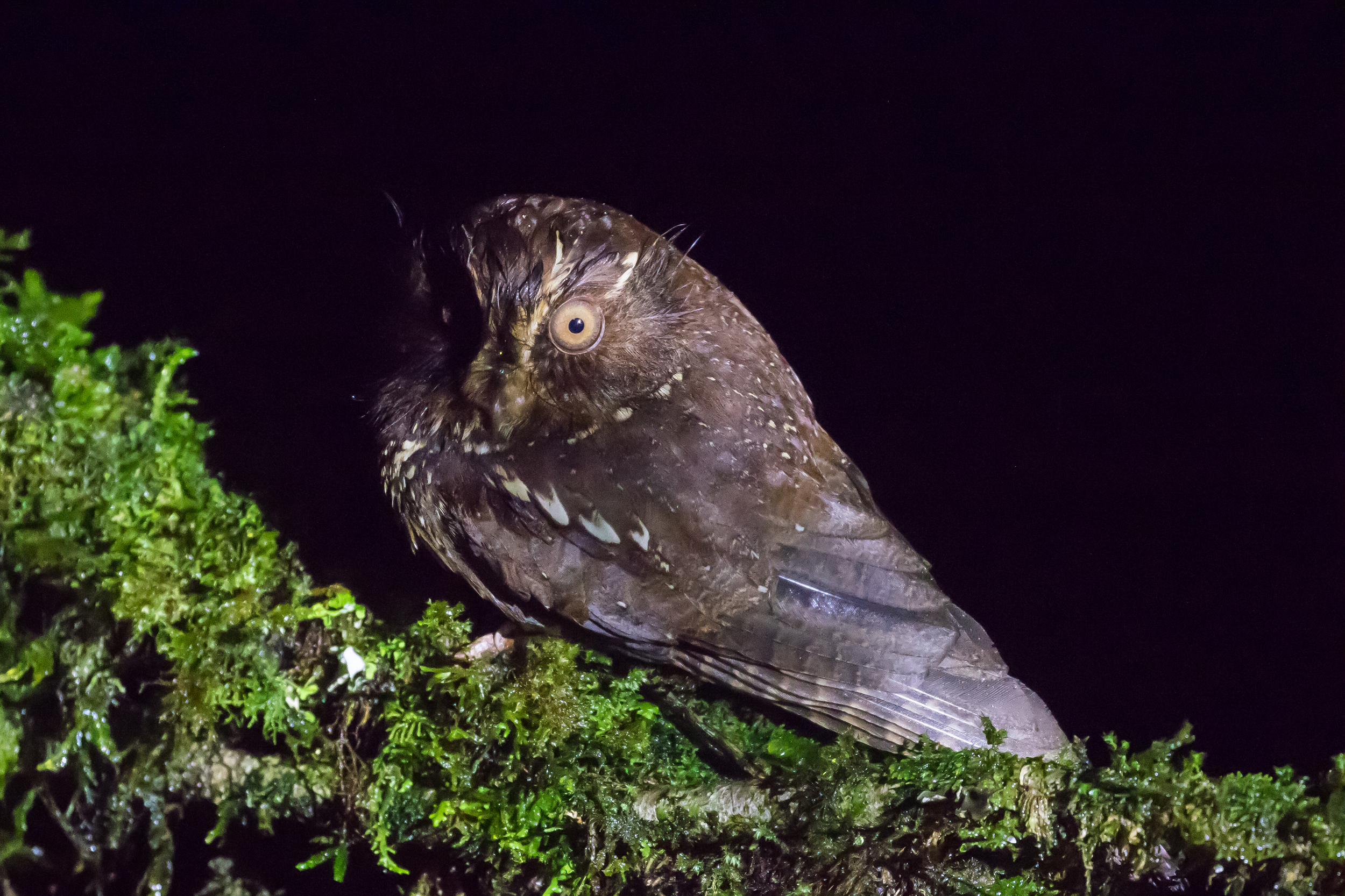
Day 14, 25/6/18, “Back in Black”
Our day begins identically to yesterday, with and early rise and walk down to the Sicklebill hides. Worryingly, although we can hear the Sicklebill calling once it gets to 6am, today the call is distant and doesn’t seem to get closer. The clock ticks on and the later it gets the more I sure the bird is not coming today, for some reason. An Ashy Robin puts in a appearance right in front of my hide providing momentary distraction.
At 6.30 the Sicklebill has still not appeared – by this time yesterday it had come and gone – and I stand up in the hide to stretch my legs. I’m on the verge of calling out to the others who are nearby but in separate hides, to see if they want to knock it on the head, when I hear something. I imagine it’s the Ashy Robin and initially look at the ground in front of the hide. When there is nothing there I raise my gaze up towards the display post. F**k me! The Black Sicklebill has silently floated in and is on the post in all his long-tailed glory – and in much better light than yesterday. He proceeds to treat us, and a female that joins, to a full-on display, including transforming himself into a metre-long spoon, and pumping his horizontal body up and down; truly weird, amazing to witness, and presumably irresistible to the female in attendance. Bizarrely, today he is silent for the whole performance — maybe with a female present he doesn’t need to advertise audibly.
Once he and the female have flown off we pile out of the hides giddy with excitement of the show we have just witnessed. Back at the camp we pack our things and commence the walk down to Syoubri, taking a loop that we are told is slightly longer but less steep than the route we took up.
Modest Tiger Parrot is our first new bird of the morning, and then between the camp and our lunch-time Paradigala stakeout we find Mountain Fruit-dove, Orange-crowned Fairywren, Garnet Robin, Friendly Fantail, Arfak Smoky Honeyeater. We even hear Black Sicklebill calling as we descend.
I am hopeful of clawing back Long-tailed Paradigala and we pass through two know territories (including revisiting Monday’s) spending a good amount of time in each. We find more Vogelkop Superb BoPs, with a male and two females in the fruiting trees, and a female Western Parotia, as well as Vogelkop Whistler and a Black-breasted Boatbill, but my luck is not in and we do not have a sniff of the Paradigala. A few hours later at 11am we carry on walking, arriving at Syoubri around midday as planned.
We meet up with Shita and Benny and they have a couple of bits of news for us: Our local guides have extended a hide for us where a young male Superb BoP has been very active, so we have a crack at that first thing tomorrow morning. They have also managed to locate a Feline Owlet-nightjar at a day roost. We will visit that straight after lunch. We are also relieved to discover that the Ducking Futch have moved on. Shita tells us she has been chatting with them and they asked after us: “Where are those big, rude, English men?”. Jon and I are most upset that they should mistake us for rude Englishmen. After all, that is a good description of Steve, but it is deeply insulting that they might mistake the Welshman and Australian for English :-).
At 2pm we pull up at a spot just below Mingre and the locals take us up a steep bank to densely vegetated, narrow trail. On a small branch in the dense vines an Owlet-nightjar is roosting – how on earth they found this I have no idea. Our views are not, in fact, as good as we have had up at Zeth’s because it is almost impossible to find an unobstructed viewing angle. Furthermore, we are in some doubt as to the identity of this bird. Though the locals have called this Feline, it looks like neither of the key suspects in our field guide: it has the striped breast of Feline, but its head pattern is much closer to Mountain, lacking the bold pale eyebrows and other facial markings. It also has a pale collar, missing in all the Feline illustrations and our photos from the previous two nights. Size-wise my impression is that it is intermediate between the two, though judging size in isolation is very difficult and error-prone. The closest illustrations we can find is of Archbold’s which has the characters of both that we have observed. But that is out of range, apparently not found in the Arfaks (though Beehler and Pratt comment in the text that it is poorly known)! Subsequent comms with experts, including Phil Gregory and Thane Pratt, confirms this as an interstingly plumaged Mountain Owlet-nightjar, and Thane even questions the validity of archboldi as a species, given the considerable plumage variation in both albertisi and archboldi and minimal DNA differences.
After the ONJ visit we drive further down the mountain and from 15.00 we are stationed in the Mag BoP hide. We can hear lots of bird activity but I am not sure what species are about and one of the disadvantages of being in a hide is lack of all-round viewing. A Rusty Mouse-warbler puts in an appearance at the display court and we hear but do not see the Mag BoP. After an extended vigil Jon, once again sharp of wit and eyes – and also once again in the right place, next to the hide “door” – looks to the left of the hide out of the door and sees a male Magnificent Bird of Paradise about 10m away. Though I ticked Mag BoP 10 years ago following brief views both in the Huon and the Adelberts, this is the first time I have had a good clear view of an adult male including his amazing curled tail wires. I enjoy the view and resist reaching for the camera. Sadly he never actually comes down to the display court.
Later, after dinner, we try for a reprise of the Sooty Owl from night one in Mingre. Jon needs it, as, I suspect does Benny. We try a few places in the village but it seems we got lucky the first night and tonight we have no response.
Day 15, 26/6/18, “Almost stranded”
Back in Mingre we have one more day and a dawn, with a few key targets still to get.
Our day begins with yet another try for Sooty Owl; behind Jon’s hut one is excitedly calling at 5am. We try for a short while but again we are disappointed. Fifteen minutes later we are in the Hilux again for a short ride to a new part of the forest just below Mingre on the way to Syoubri. We walk in the dark about 20min to a Vogelkop Superb Bird of Paradise display site, where the locals worked yesterday to increase the size of a hide specially to accommodate the three “big, rude Englishmen”. We are nervous – has the locals’ presence working on the hide yesterday caused disturbance? Will the bird come back? As we arrive we realise the viewing slots are all wrong so we cut new ones, but will this cause disturbance? They have assured us all will be well, but we have heard such reassurances before, and sometimes it is impossible to explain the behaviour of wild birds.
Fortunately our fears are unfounded and we hear a Superb Bird of Paradise calling after just a short wait. Then at 6.15 he arrives and lands on the moss covered log that is his personal display area. As with many of our BoP experiences, the light is less than ideal for photography, especially of a very dark bird, but we enjoy his “semi” performance. He jumps around on the log with epaulettes splayed, flicking them forward, and presumably practising for when a female comes. He spends an irritating amount of time facing away from us, but when he turns the extraordinary blue breast-band catches the light, and when he calls the bright yellow inside to his mouth shines in the gloom. Sadly for us, a female does not come to the log this morning, so he never goes into full “frowning mexican” display (as opposed to Greater Superb BoP which has a “smiley face” display). At the time I don’t mind too much, though in retrospect wonder if we should have returned to the hide or spent longer on our morning vigil – but in the whole scheme of things, a minor disappointment.
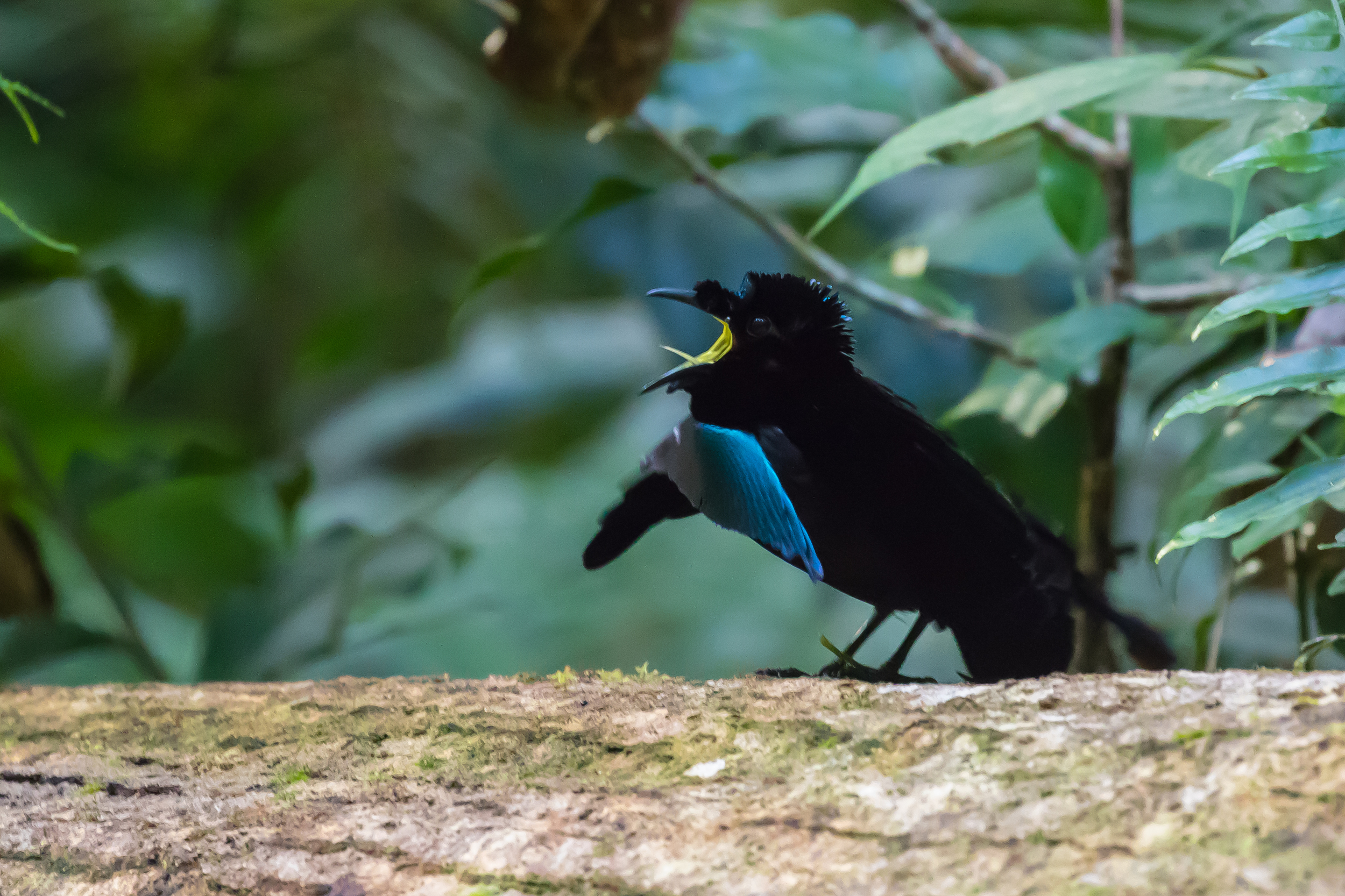
Benny comes for us after an hour or so and with the bird not present we decide to head off looking for other missing targets. Black-eared Catbirds are calling on the trail but remain stubbornly hidden, and we get no response to our attempts to find a White-striped Forest Rail.
Instead we head to a patch of forest not far from Mag BoP hide where we hope for Green-backed and White-faced Robin. We are eventually successful with former, but not before we unexpectedly hear a White-striped Forest Rail. After dipping earlier today and a few days ago, we decide amongst the three of us that we will “dictate the terms”. We direct the local posse of porters and sundry hangers-on to retreat up the trail away from us until they are out of sight. We then get Benny to put the speaker some way off – about 15m away – and we keep a low profile. It may not be ideal for photography but in the first instance we are keen to get a decent view, and keeping our distance we are less likely to spook it. This works an absolute treat – within seconds of Benny running through the call on his speaker, a small dark body rushes across the trail past the speaker and into dense cover on the other side. OK, so the view is awful, but we know it is here. It rushes back and we can now see the orange body and dark, spotted wings. It continues to criss-cross the track, maybe 15-20 times in all and we get excellent views in bins, though it is never still and always dashing fast when it is even half-way exposed. The photos are pretty basic record shots, but are good enough to show the bird definitely has spots, not stripes, making it a female. It deserves to be left in peace, so reluctantly we depart without the frame-filling pictures we’d like but with yet another good bird and another wonderful experience for the trip.

On the way back to the car we try again for the Robins and get good views of Green-backed Robin for the first time, but at 11 we return to Mingre for an early lunch. The fact we have unexpectedly got the Forest Rail this morning has opened up the afternoon somewhat. I quite fancy the change of scene, and a bumpy drive to Angi Lake would be a nice change from slogging up and down a forest trail. This area, about 40km away (which on these terrible roads means 2 – 2.5 hours in the car) is rarely visited by birders but is the site of one of the most range restricted birds we can see on this trip, Grey-banded Mannikin. Although it’s “just a manikin”, I like the sound of the adventure and manage to persuade the others that the change of scene would do us good.
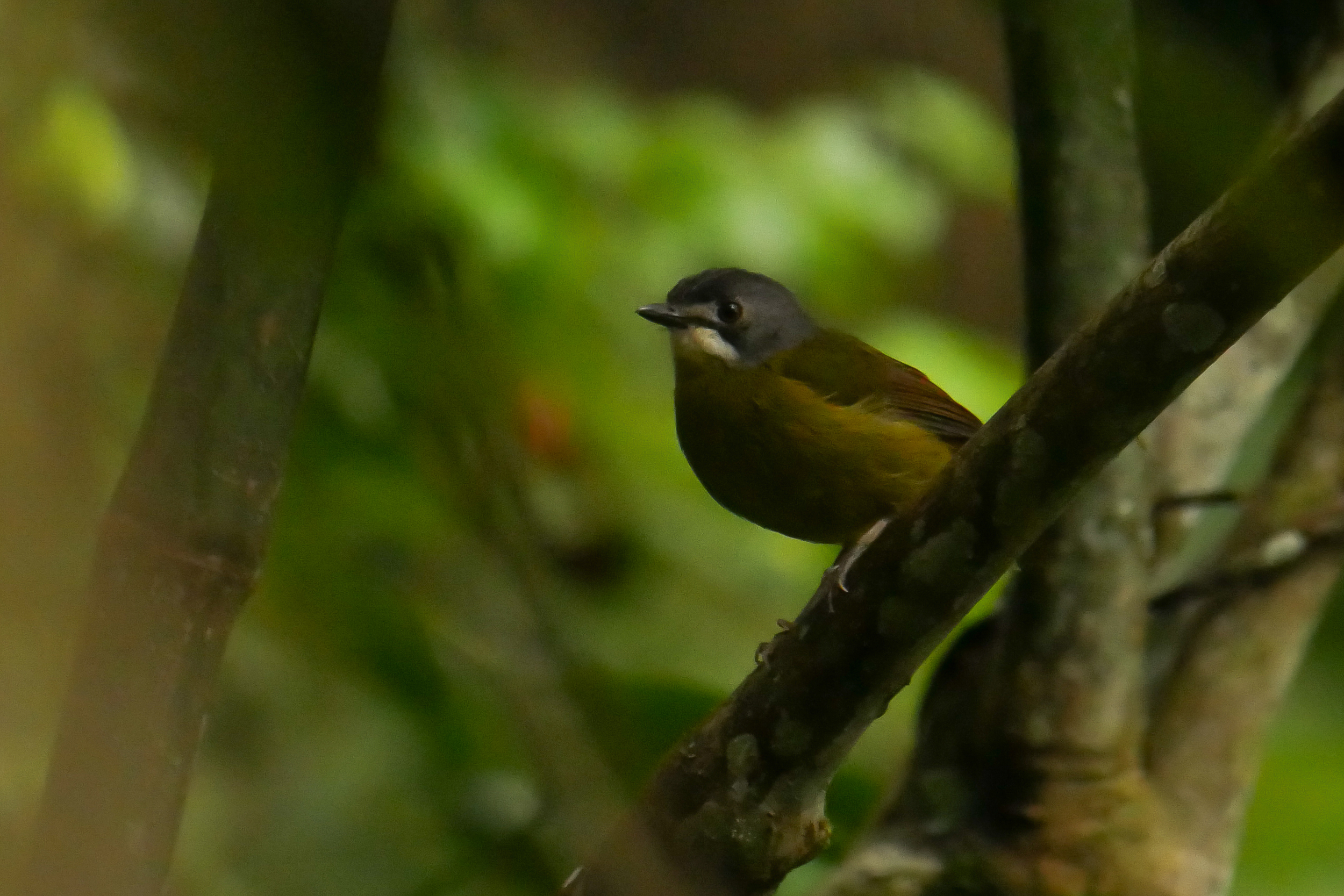
The trip to the lake turns out to be attractive to some of the locals as well, including a couple of kids for whom 5 hours in the back of the ute is a major treat! So we pile into the Hilux yet again with the 3 big rude dudes and driver Alvin inside, while Benny, two other locals and a couple of kids squeeze in the ute tray.
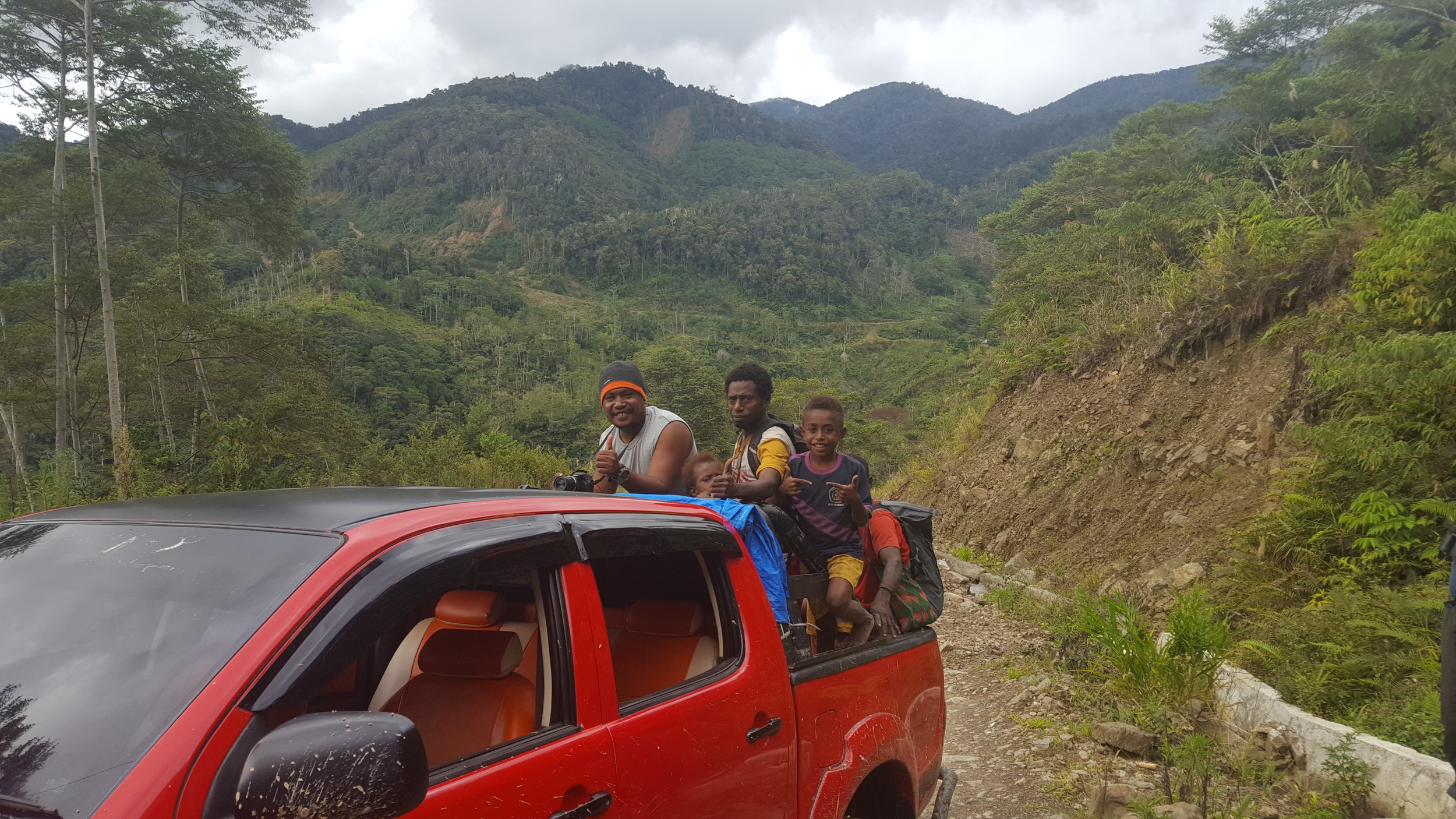
We’ve been told the road is even worse higher up but we are unprepared for just how bad it is. At one point we stop with a bunch of other cars and have to wait as successive trucks try to get up a steep, muddy, deeply rutted section and get bogged one after another. Each time there are locals on hand to help push, dig and otherwise cajole the trucks up the track – indeed I form the impression that these people are permanently employed at this section especially for this task! Beyond Mingre we notice that the forest is quite badly degraded by logging.
After just over 2 hours the road levels and we approach a village (Penibut). Alvin drives slowly along the road and we scan the grassy edges and gardens. Barely 100m into the village a flock of 6-7 birds flies up and we lock onto… a bunch of House Sparrows. Damn! But then almost immediately, from almost the same spot, a larger flock of around 20 birds lifts up and these have the obvious pale rump of our quarry. They fly 30-40m away and land in a dead tree for unequivocal (if slightly distant) views.

At this point it starts to rain, and though we will eventually get slightly better views of up to 30-40 Grey-banded Mannikins, we spend the next hour with umbrellas up and down, and getting into and out of the car. Our local posse, meantime, are hunkered down under a tarp in the back of the ute! I hope the kids are still enjoying themselves 🙂
At 15.50 we knock it on the head. The weather is not showing any signs of improving (if anything it’s getting worse) so we doubt we’ll get any better views of the Mannikins — in fact it looks like they have gone to early roost in a large, mostly hidden reed-bed. Meanwhile, we still have a 2 hour drive back to Mingre and it would be nice to complete the journey in the light.
We are about an hour into the return journey, heavy rain on the windscreen, when Alvin slows and stops. We peer through the windscreen wipers and see the reason: the road in front of us has gone, and is now just a torrent of water running down the slope and into a ditch. The surface has collapsed partway down the steep slope to our left, leaving a narrow section next to a steep slope up to the right, barely wide enough to walk along. Wisely, Alvin reverses and pulls up. We are soon joined by several other cars and various locals jump out of vehicles to inspect the damage. I grab my umbrella and likewise wander up to the edge. It does not look like we will be going anywhere fast, and first thoughts are, we will be here for the night.
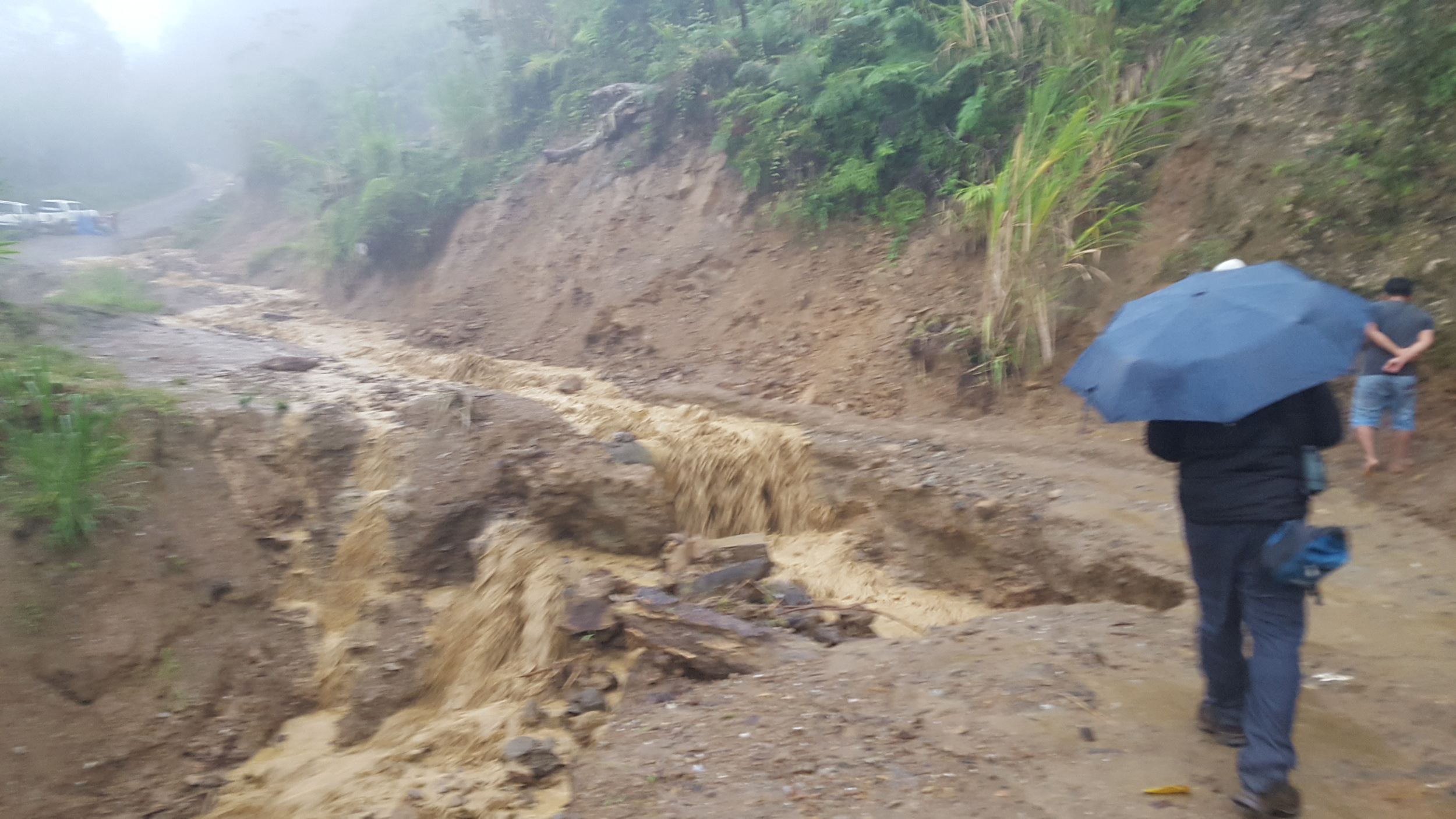
As the rain eases slightly several of the locals get to work – we are not sure what they are trying to achieve, but they use machetes to cut at vegetation, lever rocks and dig the soil and mud. To my eye it doesn’t seem to be doing much, but as events will show, what do I know? Meanwhile, Steve, Jon and I are wondering what we can do. We estimate we are about 15km still from Mingre, but maybe only 7-8 from the next village. We can’t afford to be waiting here overnight so as soon as the rain stops we set out walking with Benny. Worst case, we reckon we can cover the 15km in 2-3 hours, but more likely we will try to find some locals with a car in the next village willing to give us a ride.
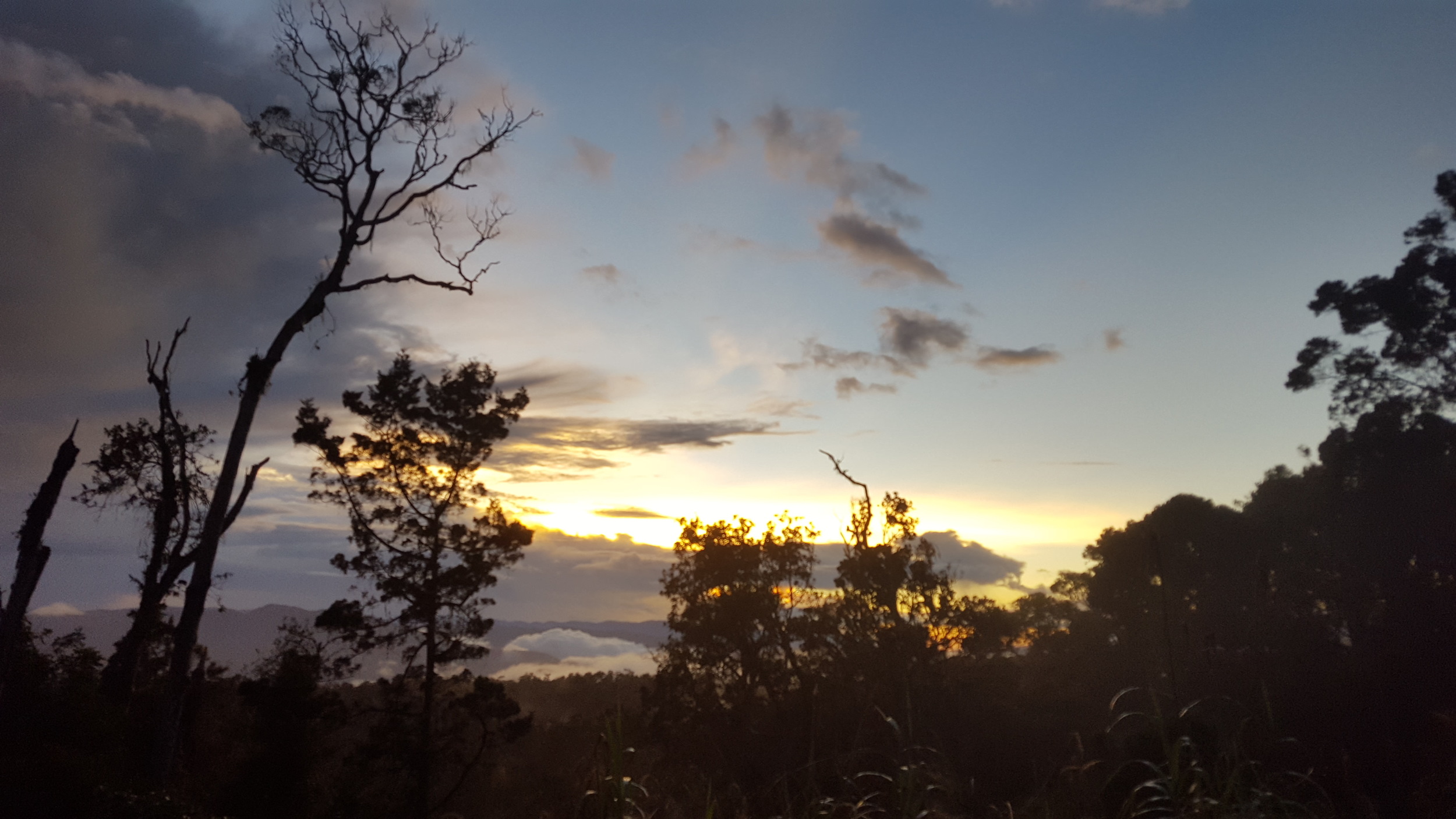
The sun sets after we have been walking for half an hour and in the torchlight I stumble into a deep puddle, water flooding over the tops of my mid-height walking boots which I are getting just about their first work out of the whole trip. My feet are soaked, but soon afterwards – an hour’s walking time overall – we see that we have reached the first houses of a village. Some locals stare at these white dudes walking down the road with torches, but before Benny can ask them anything we hear an engine and see headlights from behind. Where has this car come from? It pulls up and we realise it’s one of the cars that was stuck with us – somehow it has miraculously managed to negotiate the collapsed road. We hope we can get a lift with them and my heart sinks when they talk animatedly to Benny only to drive on without us. Fortunately, Benny explains, Alvin and the team are also through and will be the next car along.
As Alvin pulls up next to us we applaud. We, the rich, educated westerners, including an Oxford engineer and physicist have been put to shame by the resourcefulness and dogged determination of the locals in the face of adversity. I guess here, there is no other way – no road patrol or public works department or SES is going to bail you out of such a fix, so you just have to learn to do it yourself.
Alvin does not speak English, and Benny’s English is not the best, so we have to piece the sequence together in broken English and through Shita’s translations once we make it back to Mingre. It seems they have used their machetes, hands and other makeshift implements to dig away at the bank above the road to widen it. Only 3-4 cars only have made it across; Alvin is first and he floors the accelerator to make sure he gets to the other side quickly before it can collapse under him. It doesn’t and he is over! Two or three more cars follow before it has degraded again and everyone else will be waiting until morning at least.
It has not been a very productive afternoon for birding, but we have got our only target and had an amazing adventure to boot. We’ve not even really lost much birding time!
Day 16, 27/8/18, “Scratching a 10 year itch”
Over dinner after our Angi Lake adventure we have discussed our plan for today, our last morning in the Arfaks. Steve, smarting from the narrow miss of New Guinea Harpy two days ago, decides he’s quite like to spend some time in Syoubri scanning for raptors. We know from Zeth that Harpies often cruise by or even perch near the village in the hope of nabbing one of the domestic chickens for an easy meal. The word is the best chance would be 7-9 in the morning. Jon decides to join Steve. On the other hand, I have still not had the kind of views I’d like of Magnificent Bird of Paradise, despite now having seen and heard several, both here and 10 years ago. Shita arranges for Alvin to drop me at the Mag BoP hide and then return to take the others to Syoubri for a couple of hours.
A Sooty Owl is calling again this morning as I rise, but it’s a bird only Jon now needs and he’s still asleep, with Steve and Jon having a relative lie in this morning. I drive down with Benny to the Mag BoP site and the two of us are set up in the hide as dawn breaks. Not long after we hear a Magnificent Bird of Paradise and locate it on a branch at the back of the display area. It seems pretty relaxed and in no hurry, spending ages preening, testing its golden “ruff” feathers that puff out during display, and generally making itself beautiful for the ladies. Eventually it drops down to the display court and clears away a few leaves that have fallen. House-keeping done, he returns to his perch, but when a female arrives he drops down the display court again and begins a bit of a routine. Finally I have the kind of views and photos that I have desired since I ticked it off in 2008.
I am satisfied that I’ve made a good call and fairly comfortable that I’ll be ok even if they have seen a Harpy. Benny and I leave the hide and bird on our way back to the road through gardens. Benny hears a White-eared Bronze –cuckoo, perhaps the best looking of this family, but I don’t have the call to try and entice it to show itself. Likewise, Black-eared Catbird, true to its behaviour over the last couple of days is incredibly vocal but keeps out of sight. It is quite birdy as we walk up and I manage to see a few birds that are missing from the trip list, including the common and vocal but hard-to-see Long-billed Honeyeater, and I have my first views of Elfin Myzomela and Hooded Pitohui.
Up at the road, the vehicle is of course with Steve and Jon, so I have no choice but to wait and bird from the roadside. It is still fairly early and cool and there is a good level of activity. Best of all, Benny suddenly exclaims, and has found a Goldenface in a bare tree. I try to snare a record shot, but it flies. However on this occasion it flies to a shrub only about 10m in front of us and it and another spend the next few minutes feeding. They are joined by a Pygmy Drongo and a Fantailed Monarch in the same tree. We also have a Papuan Sittella and some Fairy Lorikeets bomb across the road.
The others duly arrive at around 9.40 and are probably gripped off to learn I’ve had a good bird-filled few hours. They have seen almost nothing – theirs was always a high risk strategy. We try to bring the Goldenface back, because Jon really still needs a decent look even if he has ticked off stringy views a few days ago. Sadly they are no longer in the area. We do have a nice time birding the nearby trails again, though with Boyer’s Cuckooshrike, Magnificent Bird of Paradise (decent looks in a fruiting tree, though nothing to compare with my views from the hide), Spectacled Longbill, Mid-mountain Berrypecker, Great and Black-billed Cuckoo-doves and Moluccan King Parrot.
After lunch we load up the Hiluxes and drive slowly (there is no other way) down to Manokwari, stopping and birding at various spots along the way. We do well for Longbills, picking up Spectacled (again) and Pygmy Longbill (also known as Dwarf Honeyeater). Benny is pulling out all stops to try and get Jon a Goldenface, trying every time we stop and rushing into the forest if there is any hint of response. I try to help find one, but it’s hard to keep the motivation up for this bird that I have seen so well earlier, and which is proving so elusive and time-consuming as we descend. Jon gets more snatched views as it moves about the canopy and will have to settle for this.
A key bird we do see well on the drive down is White-faced Robin. A couple give us the run-around but we nail them down eventually. They are also found in northern Queensland but I was keen to see this life bird and I am last to get on them. Various other nice taxa make it onto our day-lists, including Island Leaf-warbler, Black-winged Monarch, Ochre-collared Monarch, Red Myzomela, Fairy Lorikeet, Papuan Mountain Pigeon and Rufous-bellied Kookaburra.
The afternoon is drawing on by the time we reach lower elevations where we hope for Wallace’s Fairywren but it’s not a good time of day – we have probably chewed too much valuable time trying for birds like Goldenface and White-faced Robin – and we do not have a sniff. It is great, though, to see so many Blyth’s Hornbills, a good indicator of the quality of the forest that is still here – for now, at least.
Shita drops us at a nice looking resort hotel near the coast and airport and goes home for the night. A few minutes later there is a knock on my hotel door and a porter delivers a plastic bag with 12 cans of Bintang that Shita has just purchased from the local police station. We’re told we are not allowed to drink it in public, only in our rooms. The solution of the big rude Englishmen is to decant it into water bottles to enjoy with our restaurant fare as we do our final bird-call for the Arfaks. Tomorrow we will be heading for Sorong and Waigeo, and we hope, for an appointment with Mr Wilson.
